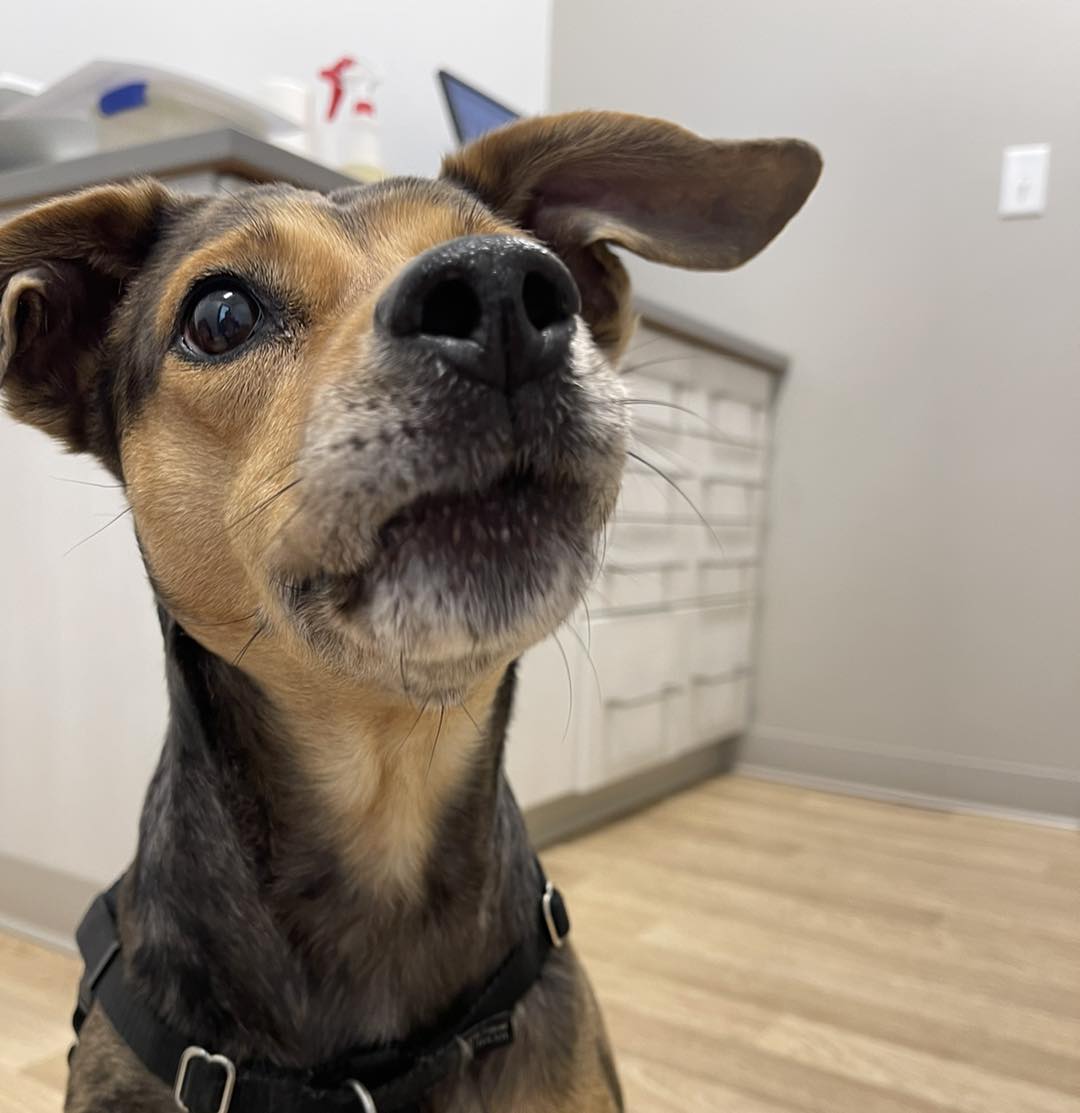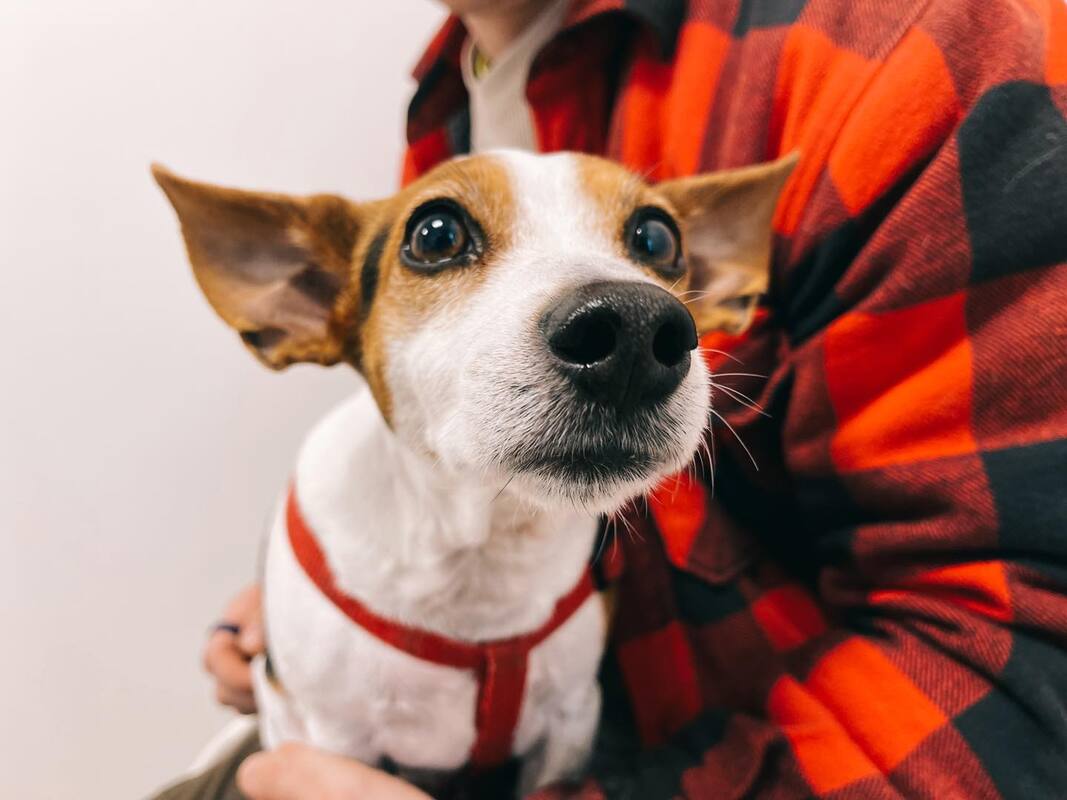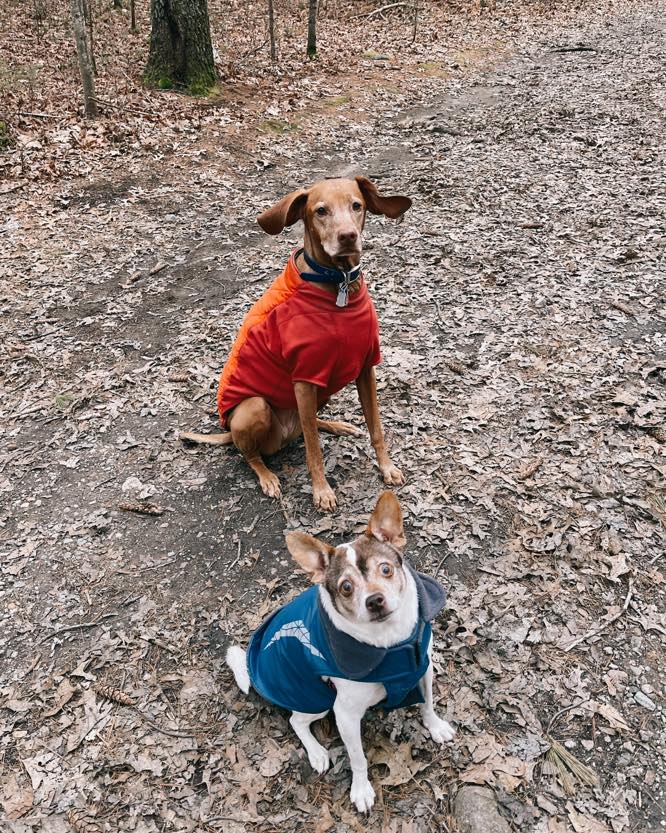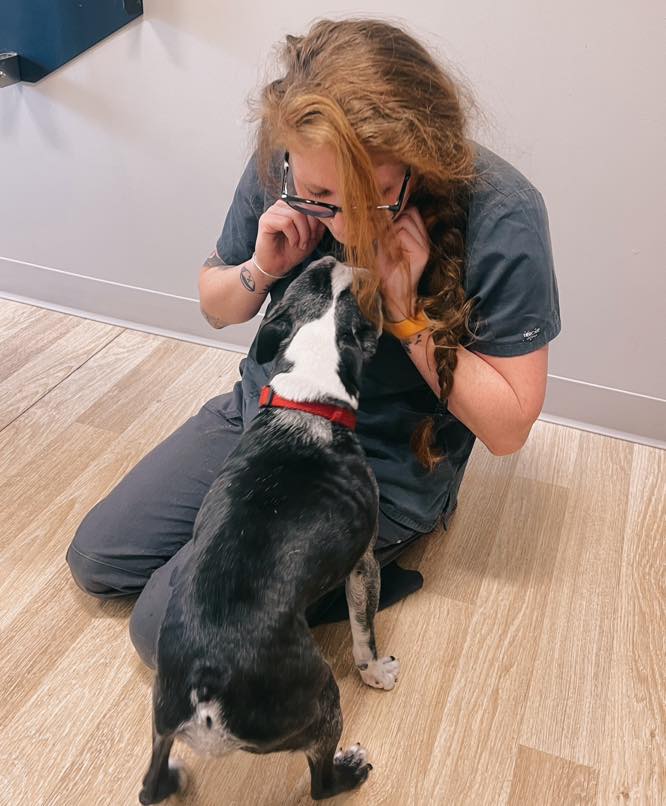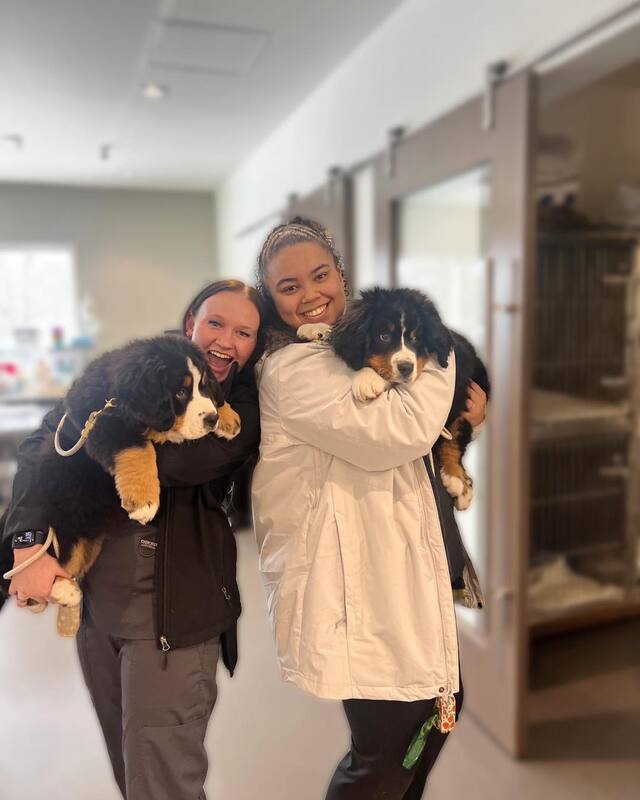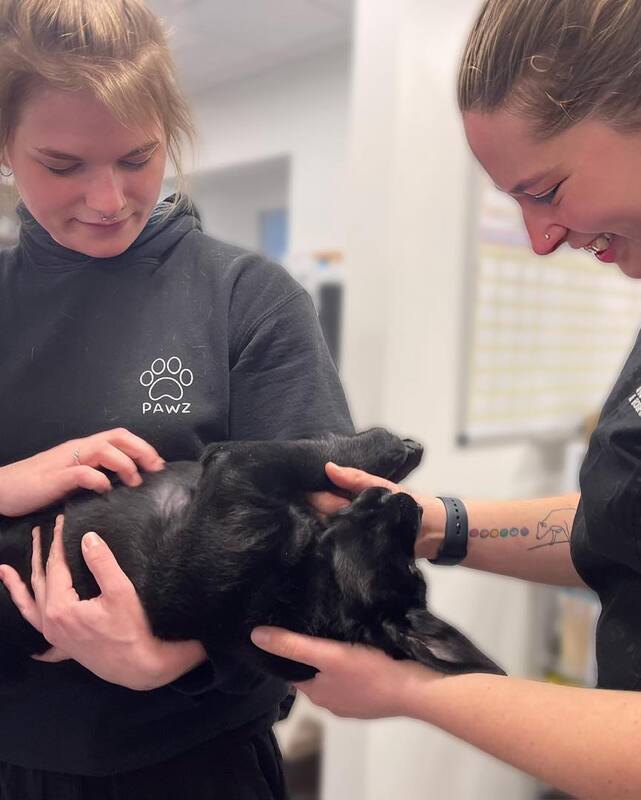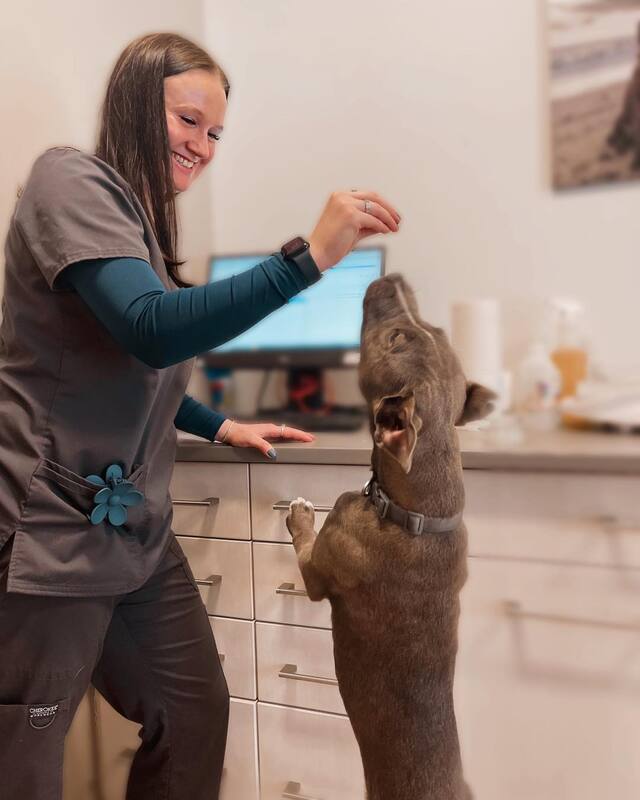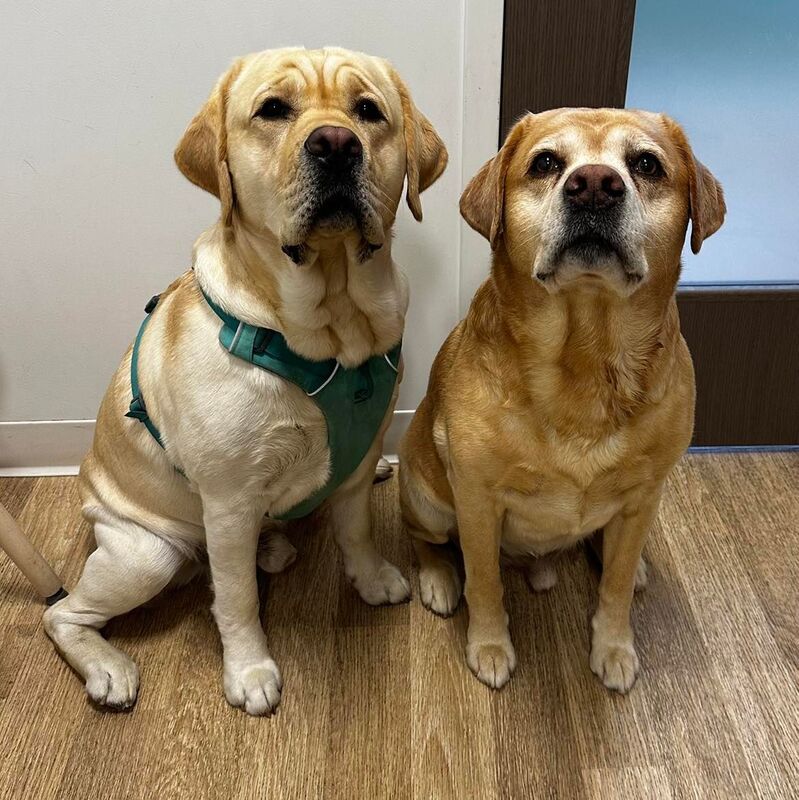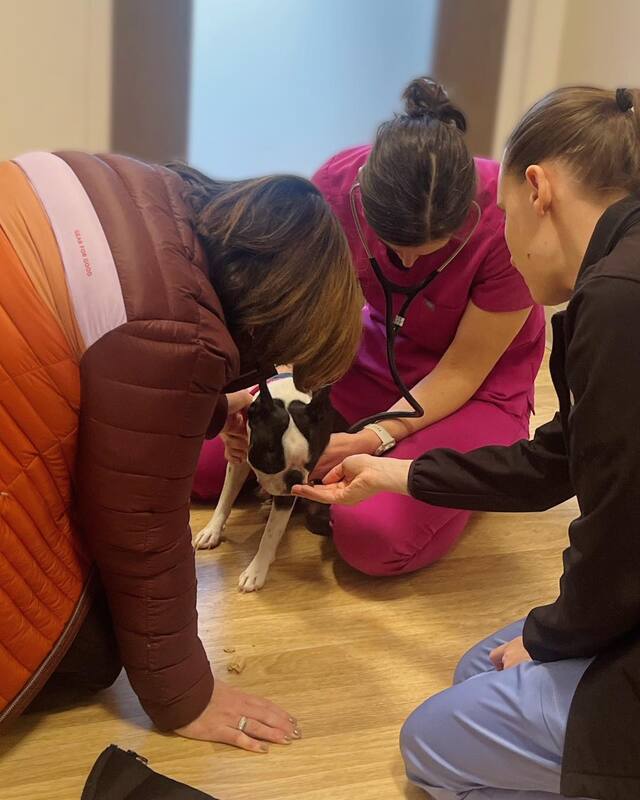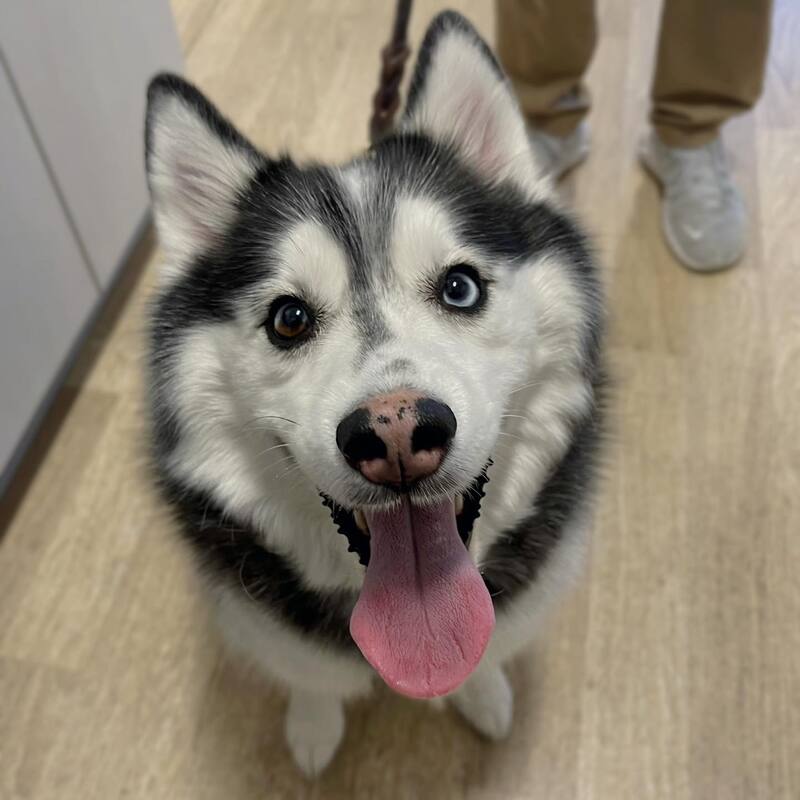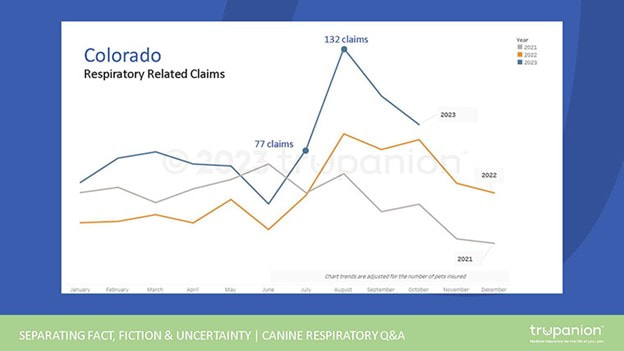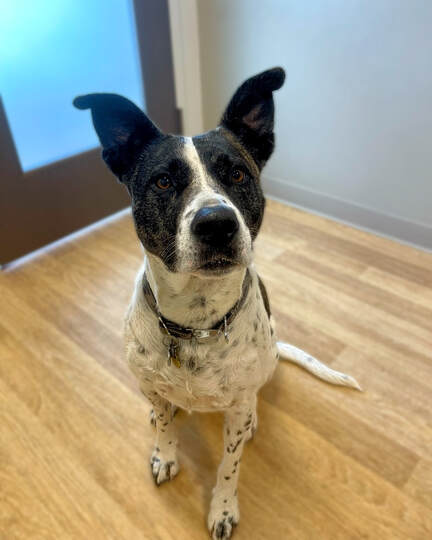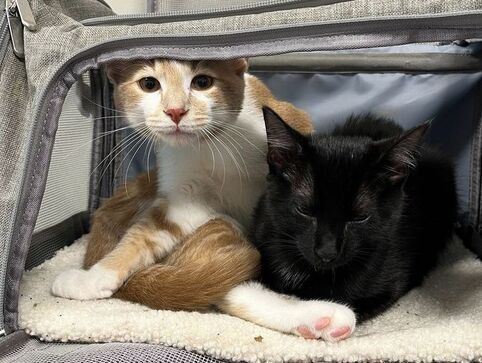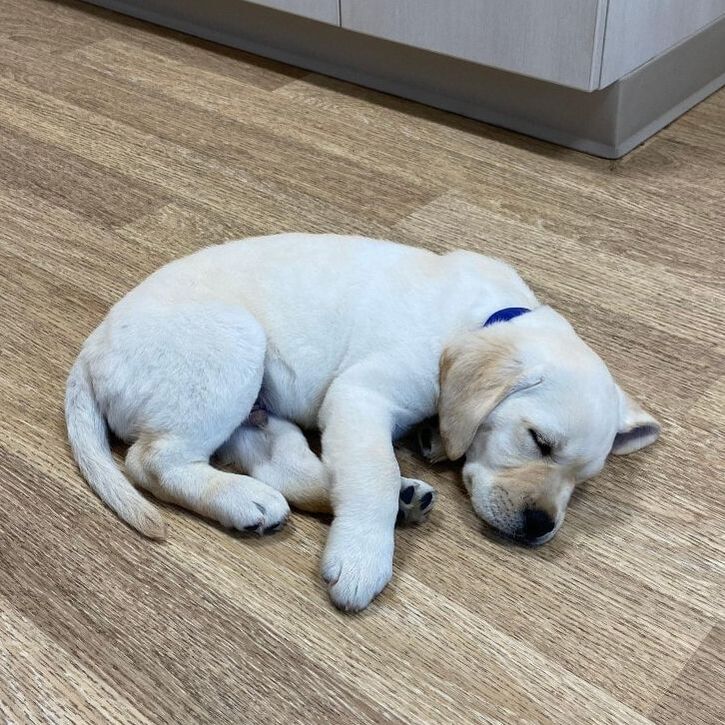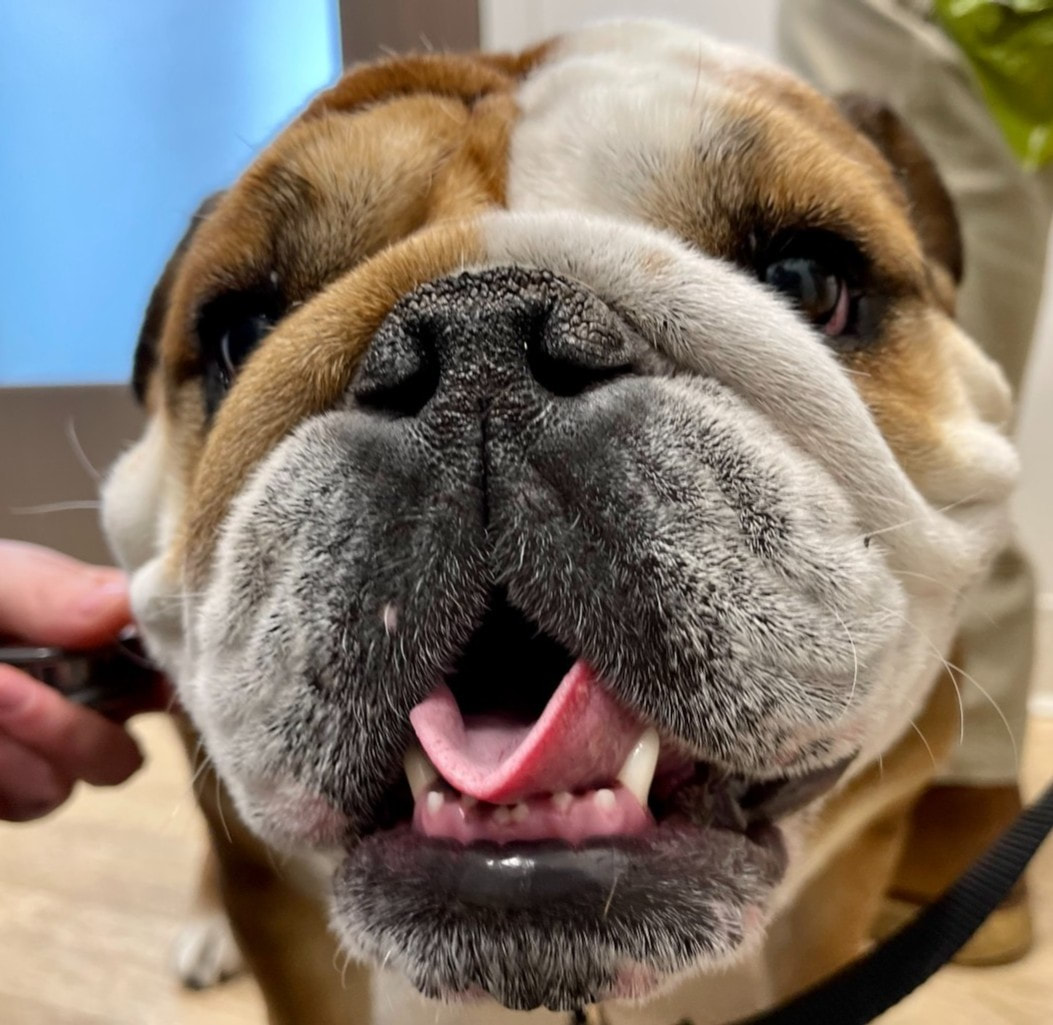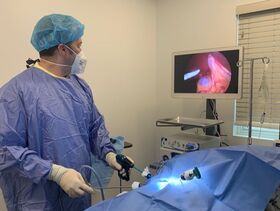 If you've been wondering where to take your axolotl, bearded dragon, or duck for care, we have great news for you. Our sister hospital in Burlington, MA, will soon expand it's services to treat most types of birds, retiles, and some amphibians. Cambridge Street Animal Hospital (CSAH) already treats exotic mammal specials such as rabbits, guinea pigs, and sugar gliders, in addition to dogs and cats. Now, with the addition of Dr. Michelle Guarin, the Burlington team is thrilled to treat even more species. Dr. Guarin will join the CSAH team in June. She has been practicing veterinary medicine since 2011 in a mix of general practice and emergency hospitals, and, most recently, as the Medical Director at the Animal Rescue League of Boston. Call 339-234-6007 or visit cambridgestreetanimalhospital.com to learn more about Dr. Guarin and the rest of our friends at Cambridge Street Animal Hospital. Of course, our team in Concord is still here to care for your dogs and cats! If you have any needs or questions, call 978-369-3503 or fill out a contact form. We look forward to hearing from you!
Dogs are intelligent creatures with a love of mental stimulation. Mental stimulation is just as important for them as physical exercise and can make dogs even more tired! Mental enrichment is crucial for our furry friends to maintain a healthy and happy lifestyle. However, sometimes life’s circumstances don’t allow for as much mental stimulation as we want to offer our dogs. We are gone for stretches of time for work or school. Our dogs have an injury or a recent surgery which restrict their normal, fun routines. Sometimes they just have more energy than we do and we need fresh ideas! We at Concord Animal Hospital have put together seven ways to keep your super smart pup stimulated and challenged. Some call for toys that you can purchase at most pet stores, Amazon, and stores such as TJMaxx, HomeGoods, or Target. Others call for creative use of what you already have at home! Concerned about your dog's health? We're here to help.
Dog getting tired of one of these enrichment activities? Rotate and Refresh! Variety is the spice of life, even for dogs! Keep your furry friend on their toes by rotating their toys, puzzles, and enrichment activities regularly. Introducing new challenges and experiences will prevent boredom and ensure that your dog's mind stays sharp.
Remember, mental enrichment is not just a luxury for dogs; it's a crucial part of their overall well-being. So, let's get creative, have fun, and unleash the full potential of our canine companions! After all, a happy dog is a healthy dog, both in body and mind. Many dogs come bounding through our front doors, ready to accept our cuddles and treats and seemingly oblivious to shots and exams. But for others, a trip to the veterinarian can be a nerve-wracking experience. The unfamiliar sights, smells, and sounds can trigger stress and anxiety even in pups that are normally laid-back. With a few simple strategies, we can help alleviate their worries and make vet visits a more positive experience for our furry friends! Here are some tips to reduce stress during your dog’s next visit to the vet. What you can do even when you don’t have an appointment:
 One the day of your appointment:
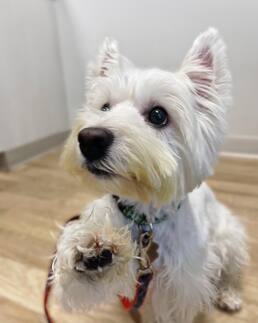 Not enough? Even with all these careful measures, vet visits are still stressful for some dogs. While some dogs may freeze when they are anxious and allow examination, some become angrier and angrier with each part of the exam. If your veterinarian feels that your pooch is still very anxious, they may recommend administration of calming medications in advance of their next visit. These medications are very safe and can make vet visits less frightening for your dog! By implementing these strategies, we can help reduce stress and anxiety for our dogs during veterinary visits. Remember to be patient and understanding with your furry companion and always prioritize their comfort and well-being. With a little bit of preparation and a whole lot of love, we can make vet visits a positive experience for our canine friends. As always, we are here to help care for your pet and answer your questions. Give us a call at 978-369-3503 or email us at [email protected] with any questions or concerns.
Welcome to the world of pet parenthood, where every tail wag and purr is priceless! While showering your furry friend with love is essential, it's equally important to consider their health and well-being and how you can plan for their care financially. That's where pet insurance comes in – a financial safety net for unexpected vet bills and medical emergencies. In this post, we'll explore the ins and outs of pet insurance to help you in your search for the right pet insurance provider and policy. The Basics of Pet Insurance Much like human medical insurance, pet insurance is an insurance policy you can purchase that can help to lessen the overall costs of veterinary bills. If your pet is seen at by a veterinarian for a covered condition, you typically pay the bill and then submit a claim to the insurance company for reimbursement. There are three common types of plans:
Decoding the Pawlicy Before purchasing any pet insurance policy, you need to do some research so you understand to benefits and drawbacks. When we see pet owners disappointed with their insurance plans, it’s most often because they weren’t aware of what costs would not be covered. Surprises are never good when it comes to insurance, so do your research so you understand what is and isn’t covered by your plan.
A few terms you should know: Deductible: the amount you pay for covered veterinary costs before your insurance plan starts to pay. For example, if you have a $500 deductible, you pay the first $500 of covered services. Your insurer will only begin to reimburse you for covered services after you have paid your deductible. Typically the lower the deductible, the higher the cost of the plan. Premium: the amount you pay each month or year to keep your insurance policy active. Premiums vary significantly based on things like your pet’s breed & age, your policy deductible, and the cost of care where you live. Coverage limits: the maximum amount your insurer may pay out for covered claims. If you file a claim with your insurer and the costs exceed your coverage limit, then you may be responsible for any remaining expenses that aren't covered by your insurance. Some insurance policies have coverage limits for the pet for the plan year or a lifetime, some have coverage limits for each of your pet’s conditions. Exclusions: a provision in your policy that eliminates coverage for certain conditions. For example, if your pet has a pre-existing condition, such as allergies, you will not be reimbursed for any allergy-related veterinary costs. Many illness plans don’t cover the cost of the sick or emergency exam fee. These costs also won’t count toward your deductible. 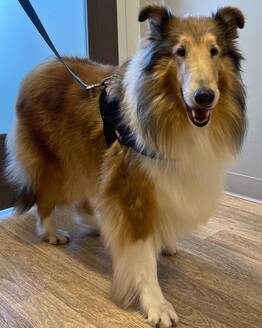 Tailored Tails: What Type of Coverage is Right For You? Once you’ve explored the different types of coverage plans available, think about the plan that works for your furry friend's needs and lifestyle and for your wallet and peace of mind. While we’d love to recommend a plan that will work perfectly for your, we know that everyone’s reasons for getting pet insurance are different! A few questions you should think about when deciding on what type of plan will work best:
Fetching Quotes and Comparisons Now that you have a sense of the type of plan you want, it’s time to fetch some quotes from different pet insurance providers. May pet insurance providers have plan comparison tools on their website, but we typically recommend PetInsuranceReview.com as a great place to start your search. Compare plans available for your pet. Look for the right balance between coverage and cost – after all, you wouldn't want to break the bank on pet insurance treats! 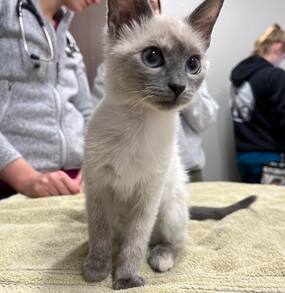 What the Doctor Recommends At CAH, we don’t recommend any particular provider or plan but we do recommend pet insurance. When your pet cuts himself in the woods and needs surgery in a specialty hospital or is diagnosed with a long-term illness that will require years of medications and care that includes regular bloodwork and vet visits, it’s a good feeling to be able to say, “yes, do it all, I have insurance.” We have one pet patient whose insurance policy has covered over $45,000 worth of veterinary expenses. Would the owner have been able and willing to pay that out-of-pocket? We can’t say, but we are 100% positive that they are glad they purchased an insurance policy! By investing in pet insurance, you’re protecting your pet but also securing peace of mind for yourself. In the worst case, you spent money on a policy you didn’t use – hopefully a policy that was within your budget. In the best, you were able to say “yes” to expensive and extensive life-saving care, care that gave your furry family member additional years of health and happiness. As usual, we’ve done our best to summarize the topic of pet insurance but we may have missed something. If you have any questions, please call us at 978-369-3503 or send us a note. 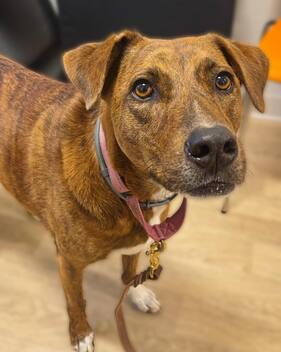 There is widespread reporting of an infectious respiratory disease among dogs that has turned deadly in rare cases. The disease has been detected in dogs across the country, including in Massachusetts. This disease is considered to be part of the canine infectious respiratory disease complex (CIRDC). What is CIRDC? CIRDC are diseases caused by several different and often highly contagious bacterial and viral pathogens and include illness such as Bordetella (kennel cough), canine parainfluenza, and canine influenza. CIRDC is endemic in dogs, meaning it’s always present wherever there are dogs. Symptoms of CIRDC include coughing, sneezing, eye or nose discharge, inappetence, and lethargy. Symptoms can last from several days to weeks. What is the canine respiratory disease observed more recently? At the moment we don’t know if this is a new disease. According to the American Veterinary Medical Association (AVMA), symptoms of this respiratory disease appear to last weeks longer than the typical symptoms of the better-known and very common Bordetella. The disease is generally resistant to standard treatments, such as antibiotics. In very rare cases, dogs develop acute pneumonia that rapidly becomes severe and often leads to poor outcomes in as little as 24-36 hours. Whether we are seeing a new disease in North America or a previously existing but undiagnosed illness is not known. In the chart below, reflecting respiratory related insurance claims submitted to pet insurer Trupanion in Colorado, we certainly see a spike in respiratory claims this fall of 2023. This increase could be the result of other factors, including a growing population of dogs, increased travel and boarding since the COVID pandemic, and delayed vaccinations and reduced socialization since the pandemic. “What the net result could be is we’ve got more dogs that have a lower level of resistance because they’ve been exposed to other dogs less over the last couple of years, and they’ve had less vaccinations. That means, just with our normal respiratory diseases that are always circulating, we’ll see more spikes in disease cases,” says Dr. Scott Weese, a pathobiology professor at the University of Guelph Ontario Veterinary College and director of the university’s Centre for Public Health and Zoonoses. Dr. Weese also states that the number of severe cases may not indicate a new disease. “When you have more cases, you’ll get more severe disease since a small percentage of dogs with CIRDC get severe disease.” 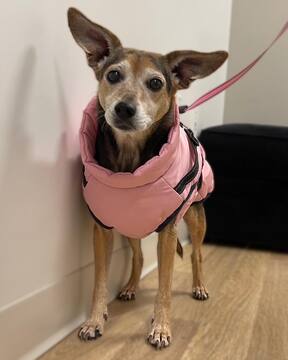 Keep your dog healthy! Whether this is a new disease or simply a bad season of CIRDC, our advice for keeping your dog safe if the same. Keep your dog up to date on vaccines. The AVMA notes that though the efficacy of existing vaccines against current cases is uncertain, maintaining your dog’s health through routine vaccinations can help support a dog’s immune system in combating disease. If your dog is a patient at CAH, they are likely vaccinated against parainfluenza virus and canine adenovirus type 2 (part of the DHPP vaccine series given to almost all of our canine patients). At CAH we typically only recommend Bordetella (kennel cough) if your dog is around other dogs a lot. As a pre-caution, we are recommending more dogs receive the Bordetella vaccine regardless of exposure to other dogs. If you are wondering if your dog should receive this vaccine reach out to us. We also carry a vaccine for canine influenza, but this disease is very sporadic in New England. If we hear reports of this disease in our area, we will begin recommending the vaccine. Some groomers, day cares, and boarding facilities may begin to require this vaccine as a precaution against CIRDC. Reduce your dog’s contact with large numbers of unknown dogs, such as at dog parks and using communal water bowls. Avoid nose-to-nose doggie greetings. At this point, it is not necessary to avoid day cares, boarding, or grooming facilities unless your dog or another dog in the home is immune compromised. The risk of CIRDC is not much greater than it normally is. Consider asking facilities about the vaccines they require and their cleaning protocols. If you aren’t comfortable with the answers, consider your alternatives. Keep your dog away from dogs that appear ill: those exhibiting a runny nose, runny eyes, sneezing, and coughing.  But if they do get sick Contact us immediately if your dog is experiencing a lingering cough, weakness, loss of appetite, difficulty breathing, worsening of illness, and a cough that is sufficiently severe that it causes the dog to vomit or makes it hard for the animal to breathe. Reach out early even with mild symptoms, as some cases advance very quickly. Be particularly vigilant if your dog is old, very young, brachycephalic (short nosed or flat faced), immunocompromised, pregnant, or has underlying heart or respiratory disease. While the disease doesn’t respond well to standard treatments, we can offer supportive care to help your dog fight off the infection. If your dog is suffering from a different illness, we can help identify and try to treat. Safety at CAH Worried about bringing your pet to see us at CAH and potentially expose them to this disease? Remember that CIRDC is endemic, so we see CIRDC cases all….the…time. We have protocols in place to prevent transmission of CIRDC and other diseases between our patients. Dogs exhibiting symptoms of diseases including CIRDC are asked to wait for their appointments in their cars instead of the lobby, exam rooms are sanitized between appointments and are disinfected with Lysol after an appointment with a patient suspected to have CIRDC or another highly contagious illness. We don’t see any more risk in bringing in your pet to CAH than there is at any other time! As always, please reach out if you have any questions: [email protected].  The air’s turning cold, the days are growing shorter, and winter is just weeks away. As much as we all love sledding, snowball fights, and warm mugs of hot chocolate, winter also brings with it some unique petcare challenges that aren’t present during the warmer months. Keep your winter more delightful than frightful by following these quick tips for winter weather safety! Frosty Fleas (and Ticks, and Heartworm): If there’s one upside to winter temperatures it’s that all those nasty warm-weather parasites have died off, right? Wrong! Ticks can be active in temperatures as low as 40 degrees, while fleas can get all the way down to 33 degrees. And while New England winters are colder than this on average, it’s not uncommon to end up with a few unseasonably warm days in the middle of the coldest months. If you’re thinking “Wow, what beautiful weather!”, then unfortunately so are those pesky parasites. That’s why we strongly recommend continuing flea, tick, and heartworm prevention year-round, no matter how cold it is. Wipe those paws: The same salts that prevent us from slipping on icy sidewalks and injuring (or embarrassing) ourselves can be rough on a dog’s paws. Wiping your dog’s paws down after a walk can prevent irritation to their paw pads, and will also keep them from licking off residue that can be harmful or toxic. Depending on how sensitive your dog’s paws tend to be, you can also consider using booties or paw balm to help protect them during your winter outings.
 Mind your mercury: You know, like they used to put in thermometers? Just like humans, dogs and cats can be sensitive to the cold, and can suffer from frostbite or hypothermia. Limit their outdoor time once temperatures hit freezing, and consider putting a sweater on puppies or dogs with short coats. Don’t leave them alone in your car either; a freezing car can be just as dangerous as a hot one! Get ready to get snowed in: There’s a big difference between “Snow day” and “Snow week.” Hope for the best but plan for the worst by making an emergency kit ahead of time, so you’ll be prepared in the case of an extended power outage or a prolonged snow-in. We recommend keeping at least three days of your pets’ food, water, and medication, as well as some special toys and treats to help keep them relaxed while they’re cooped up. And be sure to check out mass.gov’s Winter Storm Safety Tips for general advice about keeping your home and human family members safe as well!  Check your car: The inside of your car’s hood might not sound like a cozy resting place to you, but to your cat a warm, enclosed space like that is prime napping real-estate. Before starting your car make sure any cats in your house are accounted for, and check your hood or make some noise to flush out any feline stowaways. Chip ice and chip pets: If you’ve sniffed one snowflake, you’ve sniffed them all. A thick blanket of freshly-fallen snow looks beautiful to us, but it can also cover up familiar scents and make it harder for a wandering pet to find their way back home. Prevent your dogs from getting lost by keeping them on a leash during winter walks, and increase your odds of reuniting with a lost dog or cat by microchipping them and giving them a well-fitting collar with up to date contact information. For some additional winter petcare advice, check out our previous blog on the same topic. Now bundle up, light a fire, and let’s make this winter a great one!  Halloween candy and decorations have been back in stores since...well, since late summer. But now it's really almost Halloween! In just a few short weeks your house will become a treasure trove of seasonal snacks and sweets. But while your kids will enjoy digging into their sugary hauls (and you might enjoy sneaking a few pieces for yourself, we won’t tell), Halloween candy can actually prove very scary for your pets! We’ve all heard that chocolate is bad for dogs, but there are plenty of other lesser-known pet toxins that have slapped on a costume and snuck their way into your home. To help keep your pets safe this Halloween season, here’s a list of a few of the biggest dangers to watch out for! 
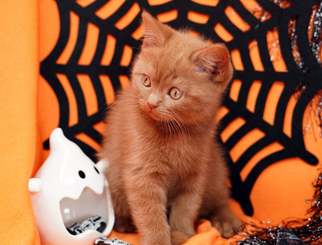
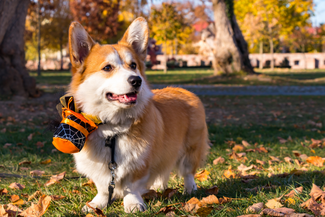 So what can I feed my pet? We get it. While it’s important to keep your pet safe, you don’t want them to feel left out on a night like Halloween! If you want your dog to be able to join you in your post-Trick-or-Treat feast you can offer them a few high-value treats. You can make a game out of it with your cat or dog with an interactive food puzzle! Halloween should be a fun night, and the last place you want to spend it is an emergency room. With all that said stay safe, and Happy Halloween! Deciding when to say goodbye to a beloved companion is one of the most difficult decisions a pet owner will eventually have to face. Sometimes these decisions loom on the horizon for a while, while other times they come on suddenly and unexpectedly. No matter how long you have to plan, these choices are never easy. While you are ultimately the only person who can make this decision for your pet, we’re here to support you however we can during the process. In this article we’ll be covering some of the most common questions pet owners have when dealing with end of life planning, offering our perspectives, and linking to resources that can help you navigate these challenges, all in hopes of helping you answer the question every pet owner dreads facing: How do I know when it’s time?  Quality of Life Quality of life is a phrase you hear a lot in these conversations, but what does it actually mean? Quality of life is a broad term used to describe and average a number of factors, such as pain, mobility, hygiene, appetite, and activity. It’s important to note that quality of life is a relative term, and a “good” quality of life will look different for different pets; if you have a lapdog who’s happy cuddling on the couch, low mobility is less detrimental than it would be in a retriever who loves hiking and swimming. Some key quality of life indicators to pay attention to include:
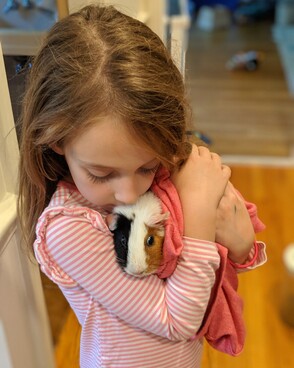 Measuring QoL Changes in quality of life are often the first thing owners notice, and this may spark other questions or considerations. It can sometimes be hard to tell whether a pet is approaching the end of their life, or whether their symptoms are a temporary low they may recover from. Since this is a deeply emotional topic for any pet owner, it can often be helpful to use tools and outside resources to get a clearer, more objective understanding of your pet’s quality of life:
 Making Arrangements Even once you’ve decided euthanasia is the next step, you’ll likely still have plenty of questions. When should you book an appointment? What will this appointment be like? Will your pet feel pain as they pass? What happens with their remains? If you know in advance that it's time, you can call us to book your pet's final visit with us. We typically recommend that you schedule this appointment for the end of the morning or afternoon, when the hospital is a little more quiet. However, sometimes your pet declines faster than you anticipate and it becomes clear that they are in too much pain or discomfort. In this case you can call us to come in on short notice. When you arrive for the appointment a technician will bring you, your pet, and any other friends or family present into our consultation room. An intravenous catheter will be placed; this may occur in the room with you, or your pet may be brought into our treatment area while the catheter is placed, then returned to the room with you. Once the catheter is placed your pet will be administered a sedative to ease any pain and anxiety, followed by an injection that will induce loss of consciousness and death without causing pain or distress. The process is short and painless; it will be over in a matter of seconds. Your pet won’t be aware of their own passing. We partner with Final Gift Pet Memorial Center for cremation and other aftercare services, enabling them to pick up remains from and deliver ashes and memorial products to our clinic or to your home, but this is only one of the many options available to you. Some pet parents prefer to make arrangements with other pet aftercare services, or to bring their pet’s remains home for burial, both of which we’re happy to accommodate.  A Word on Grief It’s normal and expected to feel grief after the loss of a pet, just as you would after the passing of any other family member. Indeed, grief is a healthy response and an important part of the healing process. Talking about grief is one of the best ways to work through it, especially if others in your household are feeling similarly; some family members may even be thankful someone else has broached the topic. Of course, friends and family can only do so much. If you’re struggling with grief and need additional support, there are resources available. Tufts University operates a Pet Loss Support Hotline, and Ohio State University’s Honoring the Bond Program has compiled numerous readings, videos, support groups, and other resources to help pet owners dealing with grief. Grief is normal, and showing these emotions or asking for help isn’t a sign of weakness. If you’re struggling after the loss of a pet, please don’t hesitate to reach out or utilize the resources above- we know it’s what your pet would want for you.  Every dog owner has heard horror stories of heartworm, and your own dog may even be on a heartworm preventative, but we still get questions about exposure, prevention, and treatment all the time. For a lot of pet owners heartworm is that thing they’ve heard of but don’t know too much about, so we’re using this as a chance to take a deep dive on the subject! To start with the basics, heartworm is a type of parasite that takes up residence in the arteries and hearts of a number of animal species, dogs included. When allowed to develop, heartworm populations can obstruct blood flow and cause irritation to the arteries, meaning an infection can potentially turn life threatening without proper intervention. Fortunately heartworm is both preventable and treatable, so let’s learn more about how to mitigate the risks of this nasty little parasite. 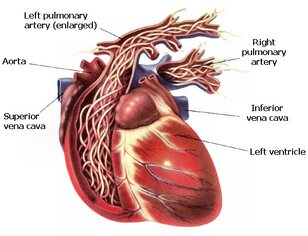 Image courtesy of ttdr.org/heartworm-information-and-prevention/ Image courtesy of ttdr.org/heartworm-information-and-prevention/ Transmission Heartworm is transmitted via mosquito bite. Mosquitos can feed off other infected animals (including those of other species), picking up heartworm larvae in the process. When the mosquito then flies to another prey and feeds again, the heartworm larvae are deposited and take up residence in their new host. The larvae burrow through tissues until reaching the bloodstream, and typically arrive at the heart six to seven months after initial exposure. Symptoms and Diagnosis Signs of a heartworm infection can vary greatly, but usually center around the heart and lungs. Infected dogs may be lethargic, and may exhibit coughing, exercise intolerance, shortness of breath, or other breathing difficulties. If a vet suspects your dog has an infection they will order a blood test to confirm the presence of heartworm. Treatment Heartworm treatment typically consists of a series of injections, with the specifics varying based on whether your dog is infected with immature heartworms (called microfilariae) or adult heartworms. These injections are administered with us in-house, and your dog may be kept for monitoring after treatment is given. These injections typically need to be spaced out, so treatment often involves multiple visits. It’s also important to keep your dog rested as they undergo heartworm treatment. As heartworms are dying off and breaking down they can travel through the lungs and bloodstream, so heavy exercise can increase the risk of complications during recovery. 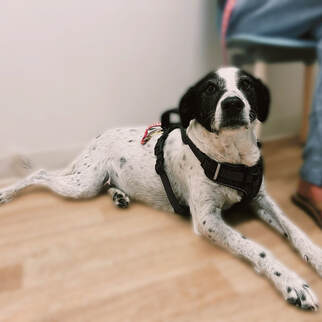 Prevention If that last section sounded scary, there’s good news! An ounce of prevention is worth a pound of cure, and heartworm prevention is both easier and cheaper than treating an active infection. Heartworm preventatives are safe medications, typically given orally once per month. While some folks discontinue heartworm preventatives during the winter months, we advise continuing them year-round for a number of reasons. Just as with fleas and ticks, all it takes is one unseasonably warm January day for mosquitoes to be rearing their ugly probosci, leading to possible exposure even when it seems like they should be safe. Since heartworms take so long to travel from the skin to the heart, monthly heartworm treatments also help to kill off microfilariae already present in your dog’s body; a heartworm preventative given in February can help to eradicate an exposure from September. Many commercial heartworm preventatives also offer protection against other common parasites, such as hookworm or roundworm, so there’s that many more reasons to use them! Questions? Still have more questions about heartworm? Worried your pet is showing symptoms, or need to get them on a preventative? Get in touch! As usual we’ve got way more information than can possibly fit in these blog posts, and we’re always happy to share.
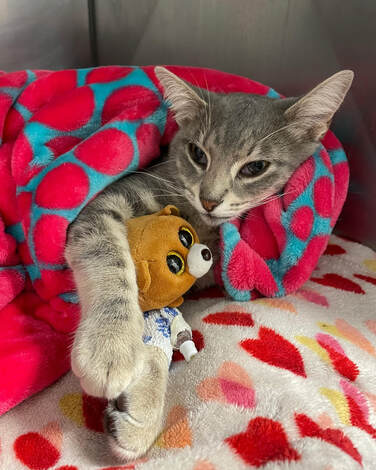 If your pet is exhibiting: vomiting, diarrhea, or lack of appetite You can try: A bland diet of white rice and boiled chicken or hamburger. This meal is packed full of simple carbs and proteins, and boiling the meat will remove excess fat to lower strain on the GI tract. If your pet has recently vomited, fast them for 6-12 hours before starting the bland diet, though pets younger than 16 weeks should not be fasted.. If they don’t seem interested in food, try adding a bit of chicken broth to entice them, and leave food out so they can come back to graze at their leisure. Once your pet’s GI symptoms have returned to normal, gradually wean them back to their regular diet over the course of a few days to avoid any shock to their digestive system. But call us if: Your observe symptoms such as lethargy, odd behavior, blood in stool or vomit, worms in feces, or pain contact a veterinary hospital immediately. If soft stool persists for 24 hours or turns into watery diarrhea or if your pet vomits more than twice your pet should be seen by a doctor. If your pet is exhibiting: itchiness, scratching, eye irritation, coughing, or sneezing You can try: Benadryl! The above symptoms can all be signs of allergies, and the over-the-counter antihistamine Benadryl can also be used in dogs and cats. Dosing guidelines are 1 mg per pound of body weight (with a standard Benadryl tablet being 25 mg), given every 8-12 hours as needed. Be sure to buy standard, original formula tablets, since some flavored or chewable versions can have ingredients that are harmful to pets. Antihistamines can also cause a bit of drowsiness in animals just as with humans, so be sure to keep a close eye on your pet after giving one. But call us if: Your pet’s symptoms don’t respond to Benadryl, you notice eye discharge with a green or yellow tint, your pet is scratching at an area of skin that is discolored or has an odor, or your pet’s coughing or sneezing becomes productive. These are all common signs of infection and typically require treatment to resolve.  If your pet is exhibiting: limping, stiffness, or soreness You can try: Limiting your pet’s activity. While stiffness or difficulty moving can be signs of an injury or other condition that requires medical attention, they can often be a case of “played too hard yesterday” or “slept on it funny last night.” Allow your pet to rest anything they may have agitated by limiting their activity for a few days; keep them on a short leash during walks, prevent them from running and jumping, and avoid high-impact play sessions. Unfortunately there aren’t any over-the-counter painkillers that are safe for animals, so avoid giving medications such as aspirin or ibuprofen. But call us if: Your pet is showing signs of pain or distress, they aren't feeling better after 2-3 days of limited activity, or their symptoms start to get worse rather than better. These could indicate a more serious injury that needs attention to heal properly, or one of the various tick borne diseases that are prevalent in this area. If your pet is in pain there are also a few prescription strength painkillers and anti-inflammatory drugs a veterinarian can prescribe that can keep them comfortable during their recovery. If your pet is exhibiting: tick bites You can try: Plucking the tick out with tweezers and monitoring. If your pet is on a flea and tick preventative and vaccinated against lyme disease, there’s not much to worry about here. Ticks have to be embedded for upwards of 24 hours to transmit most diseases, so while oral flea and tick preventatives don’t stop ticks from biting they do kill them quickly enough to avert this risk. It can also take upwards of a month for tick borne diseases to show up on a blood test or for symptoms to present, so there’s rarely a benefit to bringing a pet in immediately after they’ve been bitten. But call us if: Your pet begins to exhibit soreness, stiffness, fever, vomiting, diarrhea, or lethargy. These are all common symptoms of tick borne diseases, and if these present after a tick bite it’s time to have your pet checked out. If your pet is exhibiting: new lumps or bumps You can try: Monitoring the lump for a week to watch for any changes. Pets can get strange lumps on their bodies just the same as us, and often they’re harmless deposits of fat, skin tags, or benign tumors. While it never hurts to err on the side of caution, monitoring the bump for a little while can give a better sense of what we’re dealing with. Sometimes photographs can be enough to identify the lump as well, so if you’ve got one feel free to text (978-369-3503) or email ([email protected]) it over! But call us if: The lump grows visibly larger, is sensitive to the touch, ruptures or oozes, or has not gone down in size after a week. 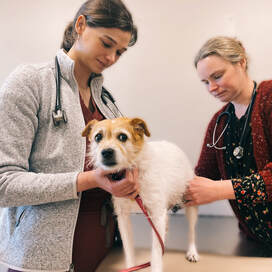 While we’ve packed this article full of as much helpful information as we could, there’s so much we don’t have space to cover! This guide is intended to be a first resource, rather than a be-all end-all, and nothing here serves as a replacement for seeing a veterinarian. It can be hard to figure out when it’s time to pick up the phone, and sometimes folks worry about bothering us with so-called stupid questions, but we’d always prefer you call us if you’re not sure. After all, it’s what we’re here for!  It’s another New England May, which can only mean one thing: summer is either right around the corner, already in full-swing, or another two months out. Regardless of whether the season shows up early or fashionably late this year, we’re taking this chance to talk about some seasonal safety tips for your and your pets. We’ve done our best to compile advice that will prepare you for any summer situation. Some of it may be old news (hot cars, anyone?), but our hope is that you’ll learn a thing or two along the way. Consider this a final exam before you and your pets have a whole summer of safe, exciting fun ahead of you!  Beat the Heat Whether you love 90 degree weather or hate it, we’ve surely got some in store. While it’s hardly a secret that dogs and hot cars are a bad combination, a lot of people don’t realize just how dangerous the heat can be. Heat stroke is a perennial summer concern, and occurs when a dog’s body is warming faster than they can cool off. Be mindful of the temperature if you’re headed outside, and try to schedule walks, play sessions, and any other high-activity plans around the cooler parts of the day. It’s important to know the risk factors as well; elderly and obese dogs, dogs with heavy coats, and brachycephalic breeds (short-nosed breeds like pugs or bulldogs) are more susceptible to heat stroke, and should be monitored accordingly. It’s not just the air to keep an eye on either, it’s the ground as well! Concrete and asphalt can get hot under direct sunlight, with asphalt often running 50 degrees hotter than the air above. A good rule of thumb (or in this case paw) is to put your own skin in the game to check. If the pavement is too hot for your bare hands or feet, it’s too hot for those sensitive paw pads as well. Grab your pup some protective booties, or save the walk for a cooler time of day. 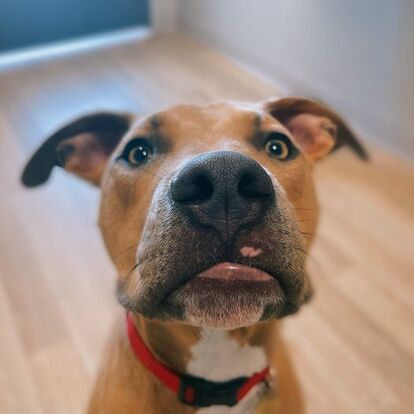 SPF: Safe, Prepared, Fun! The sun! You know, that giant ball of fire that sits in the sky and burns us if we stay outside too long? Earth’s a weird place sometimes. Unfortunately our dogs share the same sky, and they can get sunburns just like us. Exposed areas like bellies and faces tend to be more prone to sunburns, as do dogs with lighter coats or coloration, but it’s always a good idea to err on the side of caution. Try to find shade and avoid prolonged exposure to direct sunlight, and if those rays are unavoidable consider protective clothing or dog-specific sunscreen- just be sure it’s labeled for use with animals, since human sunscreens often contain ingredients that are toxic to pets. Summer Styles Whether you’re jazzed for your summer wardrobe or mourning the loss of sweater weather, your pet’s not giving it much thought. Dogs tend to be pretty good at adapting to the seasons and, while they may benefit from a slight helping hand, a gentle touch is key. While a dog’s coat can seem like a lot to lug around in summer, many breed’s coats help to insulate their bodies against hot air. Cutting a dog’s coat too short or shaving them down can result in difficulty regulating body temperature, and can also leave them more exposed to those nasty doggy sunburns we mentioned above. Dogs tend to shed in accordance with the seasons and temperature, so oftentimes a good brush will help more than a haircut. If you do think your dog would benefit from an actual summer cut, be sure to consult with a professional groomer (cough cough) to get the job done right!  The Lowdown on Lawns A nicely-maintained lawn can be the perfect spot for a summer cookout or a rousing game of fetch, but it can also play host to a handful of unseen dangers. Many of the products used to get your lawn looking good can be toxic if ingested by pets, such as fertilizers containing bone or blood meal, mulches derived from cocoa beans, and the obvious culprits like insecticides and herbicides. If you’ve treated your lawn or garden be sure to keep your pets from sniffing or rolling around in the affected areas, and if you use a landscaping service alert them to any pets on the property. It’s not just chemicals to watch out for either, since many of the same plants that make for a delightful spring or summer garden can also be harmful to curious pets. Flowers such as lilies, tulips, azaleas, and even daffodils can be toxic, as can certain vegetables like onions, chives, and unripe tomatoes. If you’ve got a garden on your property it may be a good idea to put a fence around it, for your pets’ sake and plants’ sake alike! Lifeguard on Duty While some dogs love swimming and others won’t touch water with a ten foot stick, beaches and pools can be a summer staple for dogs of all shapes and sizes. If you plan to bring your dog around water remember that certain breeds are more suited for swimming than others (retrievers and water dogs can swim laps around boxy bulldogs), and consider the value of a doggy life-vest. If you’ve got a pool on your property, keep it covered when it’s not in use! Beaches introduce a few more unknowns, but a bit of preparation is all it takes to make your day at the beach a day at the beach. If you plan to let your dog off leash be sure they have a good recall, and bring plenty of fresh drinking water so they don’t try to chug the salty ocean surf. Be mindful of others as well; on a nice day there are likely to be plenty of other dogs and people, and all the new sights, sounds, and smells can make even a well-behaved dog forget their manners a bit. Endless Summer (Safety)
We could go on forever about storm planning or tick prevention or heat stroke, but you’re probably sick of reading and ready to enjoy that summer sun, so we’ll cut ourselves off here. Fortunately school’s in session all year around, so if you still have unanswered questions or want to learn more about any of the topics we glossed over above, don’t be a stranger! We want this to be your pet’s best, safest summer ever, and we’re here to help that happen however we can. Now toss those notebooks away, enjoy that warm air, and have a great summer! In human medicine and veterinary medicine alike, diabetes is a scary word. If you have a pet who was recently diagnosed with diabetes, or simply like to keep yourself awake at night with a bunch of what-if worrying (no judgment, we all do it), you probably have a lot of questions about how to deal with this condition. Fortunately, it’s not all doom and gloom! While diabetes may be the boogeyman under the doggie bed, we know a lot about how to manage the disease. With proper management and a little TLC, your diabetic pet can still have plenty of happy years ahead of them.  What is diabetes? Diabetes mellitus is a disease that results from the body’s inability to properly process glucose. You may have heard the words glucose and insulin in passing, but in order to understand diabetes it’s important to have a grasp of what these are, and the role they play in the body. Glucose is fuel! Specifically, it’s a kind of sugar our bodies and our pets’ bodies tend to break food into, and it serves as our primary energy source. Glucose is produced by the intestines during digestion, and is then moved to the bloodstream for transportation throughout the body. Meanwhile insulin is the hormone responsible for moving glucose out of the blood and into the other cells; glucose can travel where it pleases within your bloodstream, but it can’t actually leave without a helping hand from insulin. When these two components are working in beautiful harmony, you have a healthy happy body! But when your body doesn’t have enough insulin, or when it’s not capable of utilizing the insulin it does have, we call that diabetes. You may have also heard the phrases type 1 and type 2 thrown around. They’re not the most descriptive names, but the difference is pretty simple: type 1 diabetes means your body struggles to produce insulin, while type 2 means your body can produce insulin but can’t effectively utilize it, so glucose builds up regardless. Excessive thirst and urination are two of the most common, most recognizable symptoms of diabetes." Pet vs Human: What’s the difference? While diabetes is relatively similar across species, there are a few key differences that cause the disease to stand out in dogs and cats. For a start, diabetes tends to present later in life for dogs than it does in humans. Type 1 diabetes is usually diagnosed during childhood or adolescence in humans, while it isn’t common in dogs until middle age. Type 2 diabetes is also rare in dogs, while Type 1 diabetes is rare in cats! The other key difference sounds obvious, but it’s an important one: pets can’t take care of themselves. A diabetic human can monitor their own blood glucose, administer their own insulin, and regulate their meals as necessary, but our pets have yet to master these skills. They rely on their humans for care and may not understand why they’re being poked or denied a usual meal, which can present some extra bumps along the road. Have a diabetic pet or curious how to administer insulin? Watch our how-to video! 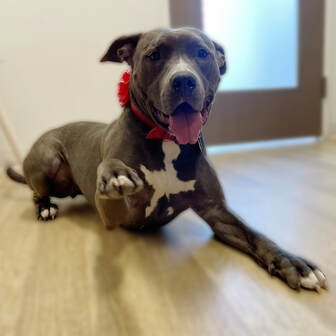 Spotting the Symptoms The sooner diabetic treatment can be started the better, so it’s important to recognize the signs early! Excessive thirst and urination are two of the most common, most recognizable symptoms. When your blood has too much glucose the excess sugar ends up being filtered by the kidneys, which draws out additional water in the process. This water is fast-tracked to urine rather than absorbed into the body, which means our poor hypothetical diabetic dog is left thirsty no matter how much they drink. Beyond this, other major symptoms to watch out for include cloudy eyes, decreased appetite, and recurring skin or urinary infections. If you notice any of these symptoms in your own pet, give us a call and we’ll figure out next steps! Managing Your Pet’s Diabetes So you’ve got the diagnosis, and you’re wondering where to turn next. Figuring out next steps, at-home management, dietary changes, and more can be a logistical challenge and a major source of stress. Fortunately managing your pet’s diabetes actually becomes pretty simple once you get the hang of it, so we’re here to walk you through the basics! Insulin administration is probably the most recognizable part of diabetic management. If your pet can’t produce their own insulin they’ll need injections after meal time, typically twice daily, to help their body process glucose. This can be one of the most stressful parts for owners who worry about hurting their pets, but fear not! Insulin needles are very thin, and the injections are administered subcutaneously (into the layer of fat underneath the skin), so your pet will barely feel a thing. Those first few injections can be stressful, but we’re happy to demonstrate and work with you until you’re giving them like a pro. Dietary changes are another key piece, since dietary management is all about regulating those glucose levels. Veterinarians typically recommend a high fiber diet for dogs and a low carb, high protein diet for cats. If there’s one golden rule of diabetic management, consistency is key! You want to be feeding the same amounts of the same food at the same time of day, and administering the same amounts of the same insulin along with it. Ensuring that you get these routines down to a science is the most reliable way to control your pet’s insulin and glucose levels, which is the ultimate goal of treatment. Conclusion
Diabetes management can be tricky. Finding the right routine can take time, and that time is often stressful for pets and humans alike. If your pet has just received a new diabetes diagnosis it may feel like too much to take in, but just remember: you’re at the hardest point right now. Every day you’ll learn a little more about taking care of your pet, and everything you learn will make it that much easier. Soon these routines will just feel like second nature! Until that time comes though, you’re not in this alone. Our staff are here to help you find a treatment plan that works for you and your pet, and to answer your questions every step of the way. 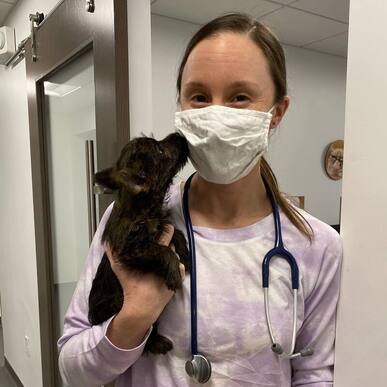 CAH Veterinarian Dr. Rondeau gets serious CAH Veterinarian Dr. Rondeau gets serious If you’re a Massachusetts resident you’re probably already familiar with our state’s progressive legislature around marijuana legalization, with the flurry of dispensaries and products, and supposed health remedies that have followed. But overshadowed by this conversation is another question that’s just as important, and one we’ve heard a lot of in the veterinary world: What the heck is CBD, and should I be giving it to my pet? CBD has been legal in Massachusetts in one form or another for a while now, and it’s only become more widespread in recent years. From liquor stores to gas stations to supermarkets, you’ve probably seen CBD products sitting on store displays without even looking for them. You may have heard a friend or coworker tell you about how CBD helps with their back pain or their sleep problems, and you may even know someone who gives CBD to their pets. But that raises a lot of big questions: Is CBD safe? Is it effective? Should I be giving it to my pet? For the answers to these questions and more we’ve brought in Tufts Cummings alumni and CAH veterinarian, Dr. Kaitlin Rondeau. 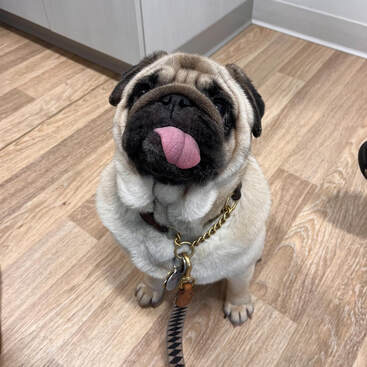 What is CBD? You’ve probably heard the name around, but what actually is CBD? “Cannabidiol (CBD) is one of two active ingredients found in marijuana, with the other being delta-9-tetrahydrocannabinol (THC),” Dr. Rondeau explains. “THC is the psychoactive ingredient and is responsible for the high people get from Marijuana. CBD has no psychoactive effect and comes from both marijuana and hemp plants.” CBD sometimes gets a bad rap because of this association, but it’s just one component of many. You can think of it like chlorophyll or cellulose; just because it exists in the marijuana plant doesn’t mean it will cause a high on its own. What are the benefits? CBD has been the subject of a bit of a health craze recently, and there are a lot of (often anecdotal) stories about its benefits and effects. CBD can potentially help with anxiety, insomnia, chronic pain, and substance addiction cravings in humans, and veterinary advocates believe it could have similar benefits in animals. But as we’ll get into, words like potentially are doing a lot of heavy lifting! Should I be giving CBD to my pets? CBD is legal, widely available, and seems to have some great benefits. So what’s the hold up? Unfortunately, for everything we do know about CBD and its possible veterinary uses, there are ten more things we don’t. For a start, there are currently no CBD products that have received FDA approval for veterinary use. “This doesn’t necessarily mean a product is bad or harmful, but it does mean there’s no oversight into whether the product does what it claims,” Dr. Rondeau cautions. It also means there’s no guarantee the product contains the ingredients and quantities it claims, and could even have unlisted ingredients or contaminants. In fact, federal law allows CBD products to contain THC in quantities below 0.3% of their weight. Without that FDA approval you can never be entirely sure what you’re giving your pet! Another equally large cause for concern is a lack of available information on how CBD interacts with other drugs. “CBD could very well be okay in a vacuum, but what if your pet is already on carprofen, or gabapentin, or phenobarbital?” says Dr. Rondeau. “Until we know more about when CBD is safe and when it isn’t, we can’t recommend it as a part of any treatment plan.” 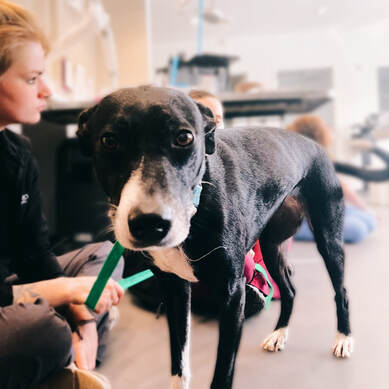 Okay, but… What if I want to use it anyway? Look, we get it. We could sit here and talk about the uncertainties and potential health risks for hours, but at the end of the day we can’t stop anyone from doing what they’re going to do. CBD probably does have veterinary benefits, and ten years down the road it could be a popular part of veterinary treatment plans. But until then, if you’re giving your pets CBD, we want to be sure you’re doing it in the safest way possible. While CBD might still be awaiting FDA approval, reputable manufacturers of CBD products should be able to offer an FDA-compliant Certificate of Analysis verifying the product’s contents. Especially if giving products intended for humans you should also be on the lookout for potentially harmful ingredients, such as chocolate or the artificial sweetener xylitol. “As with all medications and supplements,” Dr. Rondeau adds, “we advise starting at a low dose to test how your pet will tolerate the change.” But above all else, we just want you to be honest with us! We’re not your parents, and we’re not trying to get you in trouble. For the sake of your pet’s safety, we always want the honest truth about any medications, supplements, or other substances your pet might receive. All that was a lot of words to say “We just don’t know yet,” but it’s important to talk about these things! More research on CBD comes out every single day, and we’re keeping an eager eye on the findings. We’re sure we’re not alone in this thirst to know more either, so if you have questions about CBD, managing pain or chronic conditions, or anything else, give us a call! We’re always happy to do a little CBD of our own- Chatting ‘Bout Dogs, that is! 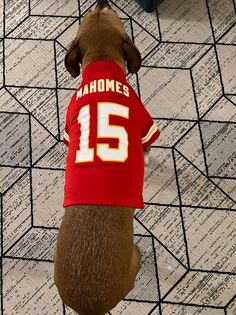 Dottie is ready to route for the Chiefs on Sunday! Dottie is ready to route for the Chiefs on Sunday! The Patriots might be down and out, but the Super Bowl must go on! We all love a chance to get together with some good friends and some good food, regardless of who’s on the field, and we hope you all have some exciting plans for this very special Sunday. But if there’s one thing worse than watching your team drop a pass, it’s watching a houseguest drop a garlic knot directly into your pup’s waiting mouth. That’s why we’ve put together this list of helpful Super Bowl safety tips, to get your pets out of the ER and into the endzone. So get ready to flag some common household dangers, tackle the safety hazards in your own home, and kick off your most pet-safe Super Bowl yet! No more football puns, though. We’re already burned out. Fine. A few more. Since you asked nicely. Play Defense at Kickoff Our first Super Bowl safety callout starts the moment you let guests into your house, and it’s… well, letting guests into your house! While you’ll be eager to greet your friends, your pets will be equal parts excited and nervous about all these strange new people in their home. Frightened pets often make a quick break for the door, which can result in them escaping and becoming lost. Keep your defensive line especially tight while letting guests in and out of your house, and consider keeping your pets closed in a separate room at the beginning and end of your party. And if you haven’t microchipped your pet, there’s no time like the present! Don’t Fumble the Food If you’re playing in the Super Bowl, your game day meal is probably full of protein and complex carbs. If you’re watching from home, wings and chips are a more likely menu. But if you’re a dog or a cat, your game day meal should consist of the same pet-safe foods it usually does (and if you need a refresher, we’ve got you covered!). While you probably don’t need to be told not to feed your dog chicken wings or a slice of pizza, well-meaning house guests may not have built up the same resistance to those sad puppy eyes. Make sure all your guests know not to share human food with pets, and keep plates and serving trays covered or otherwise out of reach. If the thought of a party where you can’t feed the pets is just too much to bear, consider setting out some host-approved kibble or treats for your guests to give instead. Unlike the real Super Bowl, now everyone wins! Concerns about something your pet got into?
 Petal looks comfortable in her cheering gear! Petal looks comfortable in her cheering gear! Rep Your Colors Comfortably The Super Bowl is all about showing off your team pride, and if you’ve bought your pet a jersey or a costume then a party is the perfect place for the big debut. But whether you’re rooting for the Pats or cheering on one of those other teams, you should always make sure any pet costume is safe and comfortable for your little superfan. Clothes can be strange and alarming to pets who aren’t used to wearing them, and they can easily restrict movement and vision, or cause overheating. Plus, your star quarterback might get more attention than they’re used to, which can cause them to become stressed and overwhelmed. Which leads nicely into our next topic… Play It Cool Super Bowl parties can be fun, but they can also be hectic - doubly so for your pets! Their home is full of strangers and so many new sights, sounds, and smells, not to mention the emotions! If you’re yelling at the TV during a touchdown or feeling stressed over a double overtime nail-biter, your pets might pick up on that and behave accordingly. That’s why it’s extra important to keep a close eye on your pet during the party, and to monitor for any signs of stress or discomfort. If you notice your pet lowering their ears, hunching up, or hiding under furniture, call a timeout and move them away from the action. Your guests might miss them, but your pet will appreciate having a quiet space to recoup before the fourth quarter. Have a Post-Game Wrap-Up The winners are hoisting the trophy and your guests are headed home, but a host’s work is never done. As strong as the urge to say “I’ll deal with it tomorrow” might be, your future self will thank you for cleaning up now. Dirty plates, half-empty cups, and dropped bits of food all pose a potential danger to pets, and should be dealt with as soon as the party’s over (or ideally, during the party itself). It may not be fun, but it’s a small price to pay to keep your pet happy and healthy! Remember the Off-Season We’ve been talking about Super Bowl parties today, but a lot of this advice stays good year-round. Just because the party is over and your jersey is packed up until next year doesn’t mean we have to forget what we’ve learned! Keeping your pet away from ingestion hazards, keeping a close eye on them when guests are over, and being mindful of clothes and costumes are all good habits that will serve you well the other 364 days a year. Of course, try as we might, we can’t answer everything in a single blog post. If you have questions we haven’t answered here, or are reading this after the Super Bowl and are worried your pet might have gotten into something at your party, make like we’re Tom Brady and give us a ring! And if you’re reading this in the present and are still ramping up to your Super Bowl party, it might not be a bad idea to bookmark our emergency resources page as well. Hopefully you won’t need it, but it’s always better safety than sorry! Alright. Puns are done for real now.  If the chilly weather, lawn decorations, and music at every grocery store haven’t already tipped you off, the holidays are growing near! While you’re racing around to find gifts for your family and friends and neighbors and your mail carrier’s nephew’s fiance, there’s a special someone who might slip your list entirely. If you couldn’t guess from the fact that we’re an animal hospital, we’re talking about your pet! Whether your pet will be eating tinsel off the tree or knocking over your menorah, they deserve a shiny new toy, too. But with so many goodies and pet products on the market, it can be hard to separate the cool from the coal. That’s why we’ve put together this handy holiday gift guide, to help you shop for the picky pups and the finicky felines in your life. While we won’t be endorsing specific brands or products, we’ll take a look at categories of products to help you figure out what’s worth looking into, and what’s just a bunch of Holiday ho-hum.  Chew Toys: As the old saying goes, every dog toy is a chew toy. Considering your pup will have their fun chewing on just about anything you give them, it’s important to make sure their toys won’t be harmful to their pearly whites. Our good friends at Veterinary Dental Services in Boxborough put together this handy dandy guide to help you determine what’s suitable for your pet’s teeth, and what’s a periodontal no-go. As a general rule of thumb (in this case literally!), anything that can’t be indented with your fingernail runs the risk of breaking teeth. So this year ditch the tennis balls and bones, and stuff your stockings with pig ears instead. They’re great for your dog, and kids love them too! Feeders, Fountains, and Bowls: It’s easy to take food and water bowls for granted, even though our pets use them every single day! While there’s nothing wrong with the tried and true dog dish, there are a handful of fancier products that might be worth your investment. Puzzle feeders and slow feeder dog bowls can turn dinner into a fun game that scratches that hunter instinct, and can also help out with those over-eager pups who eat so fast they make themselves sick. It’s a gift for you, too! Cats are also notoriously bad at drinking water, which is why we typically recommend feeding wet food. But in addition to a good moist meal, some people also find that their cats respond better to a water fountain than a still bowl. Cats are inclined to think standing water is unsafe (if only puddle-drinking dogs had that instinct), so they may be more drawn to a fountain that mimics running water instead. If you struggle to get your cat to drink enough, a fountain could be the secret to a healthy, hydrated holiday. 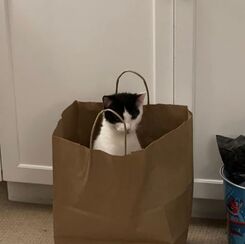 Treats and Snacks: Candy is a great stocking stuffer for our human friends, so maybe you want to share that love with your pets as well! But with so many options available, and with all the recent news on pet obesity rates, it can be hard to figure out what makes for a suitable snack. As a general rule treats should make up no more than 10% of your dog’s diet, though that still leaves a lot of room for variance- a treat that’s 2% of a Leonberger’s daily caloric intake might be 20% of a Yorkie’s! One way to help manage this is to skip the store bought treats all together, and to use lower calorie, homemade alternatives like carrots, apples, and unbuttered popcorn. If you do want to go the store bought route, pay extra attention to fat content and overall calorie count, and look for treats that contain single-source ingredients as opposed to preservatives and artificial flavorings. Supplements: Pet stores are flooded with supplements these days, with many making bold claims about curing this problem or that ailment. Considering the lack of regulation around veterinary nutraceuticals it’s good to turn a skeptical eye to these sorts of products, and it’s safe to say that a good number of supplements don’t live up to their own hype. But that does beg the question, are any of these supplements worth your money? While supplements should always be used in accordance with your veterinarian’s advice, and while they can’t treat every problem, there are particular issues where they’re worthy of consideration. Anxiety is often a complex issue that requires a combination of training and medication, but certain supplements containing ingredients such as L-theanine, L-tryptophan, magnolias officinalis, and phellodendron amurense have been shown to help with some types of anxiety. Joint pain and osteoarthritis are also issues that can require a multi-pronged approach for long term management, but supplements containing glucosamine or omega-3s can be a component in these plans. And for those dogs who have chronic gastrointestinal issues, such as frequent bouts of vomiting or diarrhea, probiotics can be useful to help get these under wraps! DIY Toys: They say nothing beats a homemade gift, and that’s as true with pets as it is with people. Whether you’ve got a dog or a cat, there are plenty of DIY presents you can put together without having to break the bank or brave the mall around the holidays. Plus, we’re sure you have more boxes than you know what to do with this time of year, so here are some ideas! Dogs tend to be fairly food motivated, so there are plenty of toys, games, and puzzles you can put together to make them work for their treats. Cardboard boxes, paper towel tubes, and muffin tins can all be turned into puzzles with minimal effort, and if you’re feeling especially ambitious you can even make a furniture obstacle course around your house! Cats are a little less treat-obsessed than their canine companions, so you can get a bit more creative with their entertainment. While puzzle feeders are certainly still on the table, you can also turn cardboard boxes into sprawling cat manors and labyrinthine mazes. If you’ve got a couch potato kitty, you can even set up a TV feed with a tablet and some bird or fish videos. Have you already shopped and dropped? If you can't bring yourself to visit one more store - actual or virtual - we understand. The gift of your love and affection is secretly all they really want, so let them unwrap a snuggle direct from you and this will be their best holiday ever!
 Thanksgiving was a great opportunity to reflect on all the positives in our life, and there’s certainly no shortage of things we’re thankful for (our awesome staff, our wonderful clients, and getting to spend every day with so many lovely pets, to say the least)! But as easy as it would be to go on for pages and pages about all the things we’re grateful for, now that Thanksgiving is over we’re turning our focus somewhere else: our pets themselves! Our pets might not be able to tell us the things they’re thankful for, and if you’re a cat owner you might doubt they’re ever thankful for anything at all. But even if they don’t always show it, your pets are glad to have you in their lives! So while you were putting turkey and stuffing in your mouth we were putting words in theirs, and sharing the top five things we’re sure your pets are thankful for. 
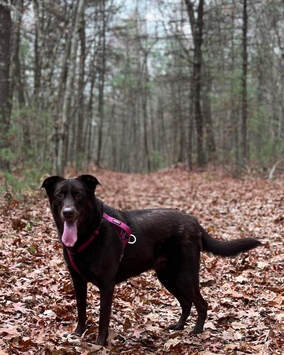 It should go without saying that this list is non-exhaustive. We didn’t have room to include long games of fetch, or your pet’s special squeaky toy, or quality time with their very favorite human. You make your pet’s life better every single day just by being there, and we know they appreciate that, even if they can’t say it. So when you sit down for Thanksgiving dinner this year (remember not to share!), take a moment and give yourself a pat on the back for all the hard work you do. If you close your eyes and listen really hard, you might just hear your favorite pet giving a toast. 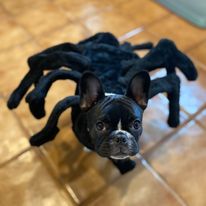 Petal Wilson ready to terrorize the neighborhood Petal Wilson ready to terrorize the neighborhood Do you feel that? The nights are growing longer, the air is growing colder, and there’s something sinister lurking around every corner. While we all know Halloween candy can pose a threat to our pets and trick-or-treaters can give them a fright, this year we’re talking about a lesser-known danger that’s just as sinister. It’s a danger that lurks in plain sight, a danger that few of us ever think about, a danger that’s coming from inside the house. This year we’re talking about… Decorations. We all enjoy turning our homes into dens of dastardly horror this time of year, but we rarely think of the plastic skeleton in the corner as an actual threat. Our fuzzy friends, on the other hand, might not recognize the difference between play danger and real danger- and as it turns out, that difference might be smaller than you think! This month we’re talking about Halloween decorations, and sharing our top tips to haunt your house without having to haunt the vet’s office. So steel your nerves, find a safe place to hunker down, and read on… If you dare.  Pupmkin's without candles are Jules-approved decorations Pupmkin's without candles are Jules-approved decorations
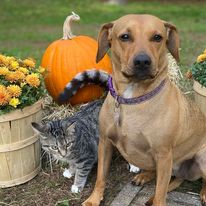 Harper & Kitten pose for a purr-fectly safe fall picture Harper & Kitten pose for a purr-fectly safe fall picture If this were a horror movie you’d have to face these dangers alone, or perhaps with a group of ill-fated friends, but fortunately it’s (probably) not. We want you all to have a Halloween that’s fun and spooky while still remaining safe, and we’re here to answer any questions you might have. If you’ve got concerns, whether they’re about decorations or general Halloween safety, feel free to get in touch! Less than half of our staff have been possessed by malevolent spirits, so our advice is usually trustworthy. Acupuncture! It’s a treatment some of you may have tried for yourselves, but did you know it can be beneficial to your pets as well? Did you also know it’s a service Concord Animal Hospital offers? Dr. Kathryn Carpenter is our resident acupuncturist. She graduated from Tufts Cummings School of Veterinary Medicine in 2011, and earned her certification in veterinary acupuncture from Curacore Integrative Medicine and Education Center in Fort Collins, Colorado in 2017. She joined Concord Animal Hospital shortly after, and has been offering veterinary acupuncture ever since! We recently sat down with Dr. Carpenter to discuss the basics of veterinary acupuncture: how it works, what it can do, and whether it might be a good fit for your pet. So without any further stalling, let’s get to the point about acupuncture! 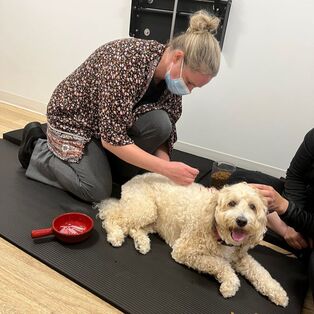 Pearl, pictured with Dr. Carpenter, doesn't seem to mind the pokes! Pearl, pictured with Dr. Carpenter, doesn't seem to mind the pokes! What is acupuncture? Acupuncture is a non-surgical, non-pharmaceutical procedure that works by inserting thin needles into specific points on the body. These acupuncture points were originally believed to impact the flow of qi, the life essence at the focus of most traditional Chinese medicine. “These days,” Dr. Carpenter says, “we recognize acupuncture points as key points on the nervous system, such as points where nerves exit the spine or join with muscles. Targeting these areas can shift the nervous system into a relaxed state, known as a parasympathetic response.” What are the benefits? Lots! Acupuncture is most commonly used to treat musculoskeletal and neurological conditions: everything from arthritis to hip dysplasia to spinal cord disease. But there’s also evidence showing that acupuncture can aid in the treatment of other systemic diseases and inflammatory conditions, such as inflammatory bowel disease, asthma, skin allergies, and chronic rhinitis. If you think acupuncture might be a good fit for your pet, give us a call! Will my pet really tolerate all those needles? Yes! The needles used in acupuncture are much smaller than the needles used elsewhere in veterinary medicine. According to Dr. Carpenter, “pets don’t typically mind the needles even if they’re the sort to throw a fit when it comes time for vaccines or blood draws. Many pets enjoy the calming sensation the needles produce, and a few have even fallen asleep during the appointment.” When asked whether she has ever fallen asleep during an appointment, Dr. Carpenter declined to comment 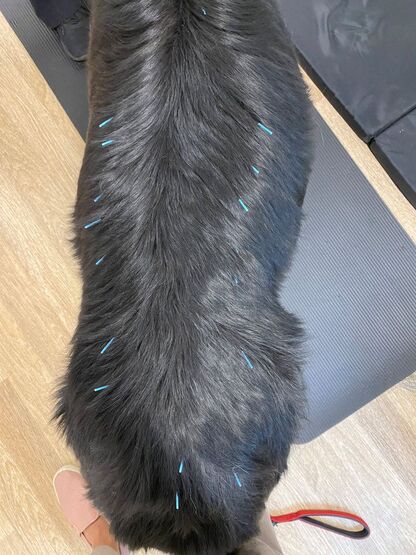 Bernese mountain dog Keri feeling good mid-treatment Bernese mountain dog Keri feeling good mid-treatment I’m interested in acupuncture. How do I go about setting up an appointment? New acupuncture patients should set up an initial one hour appointment with Dr. Carpenter. “During this appointment I’ll perform a myofascial palpation exam [a hands on exam that can help detect areas of pain, tenderness, weakness, and tension]. We’ll also discuss your pet’s medical history and set treatment goals: reducing pain, increasing mobility, or anything else you’re hoping to get out of acupuncture.” During the second half Dr. Carpenter will perform the first session of acupuncture and will help you to develop a treatment plan moving forward. Follow-up appointments are usually 30 minutes booked every week for the first one to two months, and will taper from here as needed. I have more questions that aren’t answered here! Well then, feel free to reach out! If you’ve got more questions about acupuncture, or are wondering whether it’s the right fit for your pet, give us a call! We’re always happy to chat, and Dr. Carpenter can’t wait to meet your pets! Travel! Remember that? It’s been a minute since most of us have been jet setting off to other countries. But as things settle down and borders open up, a lot of us have been bit by that travel bug. International travel is already a complicated beast and it only gets harder if you’re planning to bring your pets with you. Every country has different requirements and it can quickly turn into a maze of paperwork and appointments and restrictions. But fear not! Concord Animal Hospital has two USDA accredited veterinarians who are here to help with your international travel needs. Today we’re sitting down with Dr. Katherine Aubert, to cover her top tips for international travel. Start planning early! Like, really early. The sooner the better. Every country has its own requirements for international travel, and between processing times, required tests and vaccinations, and waiting periods, we’ll want as much lead time as possible. Dr. Aubert recommends giving a call as soon as you start making travel plans so that we’ll have a head start on sorting through requirements and preparing necessary documents. You should also let us know as soon as you have flights booked, since many countries require certain things to be done within a very short window before your arrival. “For example,” Dr. Aubert says, “most countries require an exam by a USDA accredited veterinarian within ten days of your arrival. If you start making plans last minute, it can be hard to find the time to make these appointments happen.” Keep your records organized! If you’re preparing for a relaxing vacation then paperwork is probably the last thing you want to worry about, but a little organization now will save you a lot of hassle later! Different countries have different forms that need to be filled out and different records that need to be provided, but one of the most common is a rabies certificate. For many countries you will need an original copy of your pet’s rabies certificate, including their microchip number, signed by the administering veterinarian in blue ink. Some countries may require additional vaccinations, parasite treatment, or other treatments or procedures. So basically, the more documentation you can come with, the better! 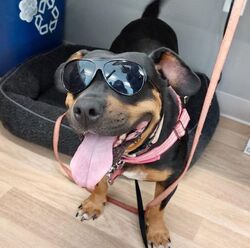 Going somewhere sunny Endy? Going somewhere sunny Endy? Double-check that microchip! Many countries require that your pet have an ISO compliant microchip for identification abroad. Not all microchips meet ISO standards; the ones we use at Concord Animal Hospital do, so if your pet was microchipped here you’ll be all set! If your pet was microchipped at another clinic you should check with them to see if the microchip is ISO compliant. If it is not compliant, we’ll typically want to administer a new microchip that is. Leave time for titers! Some countries (such as most European Union members and many Caribbean islands) will require a rabies titer prior to arrival. A titer is a special test that checks the antibody levels present in your pet’s blood to ensure they’re truly protected against a given disease. And while that sounds pretty straight forward, there is a catch; “Rabies titers have to be sent out to special reference laboratories, and typically take 4-6 weeks to process,” Dr. Aubert cautions. So to reiterate point one, start planning early! The last thing you want is for your entire trip to be ruined because a lab didn’t come back in time. 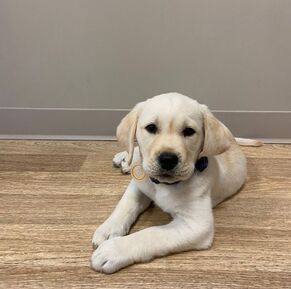 Certify your health! Most countries will require an International Health Certificate, signed by a USDA accredited veterinarian (like Dr. Aubert or Dr. Hardie!), after an exam conducted no more than ten days prior to your arrival in your destination country. “Some countries have longer exam periods or don’t require a certificate at all,” Dr. Aubert says, “but these are the exceptions rather than the rule. After your exam we’ll submit the necessary paperwork to the USDA offices in New York. The approval process can take several days, and then the USDA will overnight you a hard copy of your endorsed certificate, which you’ll need to bring with you while traveling.” So, at the risk of sounding like a broken record, call us early! The sooner you start making plans and getting appointments set up, the more likely we’ll be to get everything arranged in time. Consider giving your pet a vacation of their own! While we all want our pets to join us in our beautiful vacation destinations, travel can be stressful for the little ones. Unfamiliar surroundings, hectic airports, and long flights in cooped up carriers can quickly leave your pet needing a vacation from their vacation. “If you’re only going to be abroad for a week or two,” Dr. Aubert says, “consider leaving your pet with a sitter, a family friend, or a boarding facility. They might be happier for it.” Give us a call! Every country is different! That’s a beautiful sentiment about the diversity of our big wide world, but it’s also a factual statement about international travel requirements. To check the requirements for your destination you can visit the USDA’s Pet Travel Website, which offers a country by country breakdown of precisely what you’ll need. But of course, we’re always happy to help as well! If there’s one thing we hope you’ll take away from this article it’s, you guessed it, call us early! The sooner we can start planning, the more we'll be able to ensure your vacation goes off with less hitches and more scritches.
Vaccinated, Unvaccinated, or Not Currently Vaccinated? Before we get into all the different rules and regulations, we need to define some terms. Vaccinated and unvaccinated are pretty self-explanatory, but you might be scratching your head over the difference between unvaccinated and not currently vaccinated (I even got them backwards while I was writing this paragraph). Fortunately it’s actually pretty simple: an animal who currently has an up-to-date rabies vaccine is considered vaccinated. An animal who has previously received a now out-of-date rabies vaccination is considered not currently vaccinated (remember that at CAH your dog’s first rabies vaccination will last for one year, and all future boosters will last for three years - we only administer one-year vaccinations for cats). An animal who has never received a rabies vaccination, or received their first vaccination less than 28 days before the bite occurred, is considered unvaccinated. Easy, right? Pet not up to date on their vaccines? Let's fix that asap! Call to book a vaccine appointment today. Scraps at the Dog Park We’ll start with what to do if a domestic animal bites another domestic animal. Maybe your pup got a little too close to an unfriendly stranger at the dog park, or maybe playtime with a housemate got a little too rough. If your pet bites or is bitten by a domestic animal belonging to another person, get their information, and give them yours. If your pet is bitten by another domestic animal who is identifiable, the biting animal is quarantined within the owner’s home for 10 days. If the other animal is not identifiable, your poor pet ends up in quarantine for 45 days! They don’t want that, and we’re sure you don’t either. If your animal happens to be the biter they’ll have to go into a 10 day quarantine. This means they should be kept inside your home, should not have any contact with other people or animals, and should only be taken out on-leash to use the bathroom. The word quarantine sounds scary (and might bring back some unpleasant memories of early 2020), but fear not! While dog bites and quarantines do need to be reported to the town, you aren’t in any trouble and no punitive measures are taken. You won’t be fined, your dog won’t be taken away, and you have nothing else to worry about. The only purpose of these quarantines is to prevent the possible spread of rabies while your dog is monitored for symptoms. 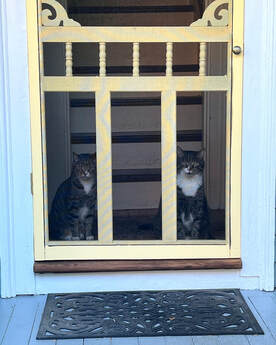 Tussles in the Woods If your pet gets bitten or scratched by a wild animal while out for a walk, or ends up with a wound of unknown origin, the rules are a bit different (and unfortunately a bit stricter). If your pet is vaccinated or not currently vaccinated and they get scraped up in the woods, you should bring them in as soon as possible to have their rabies vaccine boostered - this is the case even if your pet is currently up-to-date. After this your pet will need to go into a 45 day quarantine to monitor for rabies symptoms. If your pet is happy and healthy at the end of this period, no further action is taken. If your pet is bitten or scratched by a wild animal or receives a wound of unknown origin and they’re unvaccinated they should also be vaccinated as soon as possible, after which they’ll have to go into a four month quarantine. If your unvaccinated pet had contact with a wild animal that is confirmed to have been rabid by a state laboratory, they’ll need to spend the first 3 months of this period in full isolation at an approved animal hospital, kennel, or livestock quarantine facility. Fortunately this is easily avoided by vaccinating your pet before it becomes necessary!
In Summary… So there you have it! Hopefully this post has answered your questions, and has helped to make the prospect of an animal bite a little less scary. We were mostly focused on the protocols and the paperwork, but that does leave off one of the most important pieces of advice: if your pet ends up with a bite or a scratch from any source, you should always have them checked out. We can clean up the wound, make sure it’s healing properly, help prevent infection, and even give your pet some pain meds if they need them. As always, we try to cover what we can in these blogs, but we’re sure we didn’t get to everything! If you’ve got any other questions we’re always happy to chat, and if you do ever find yourself dealing with animal bite just give us a call and we’ll be glad to help you through it- but fingers crossed you won’t have to make that call any time soon! 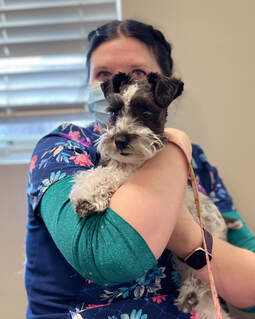 CAH Technician Mary enjoying a snuggle CAH Technician Mary enjoying a snuggle It’s no secret that our pets make us happy. We all love being bombarded with animal attention as soon as we walk through the front door, and even a cute pet photo can be enough to brighten our mood on a crummy day. But the connections we feel to our furry friends run even deeper than that! May is Mental Health Awareness Month, and it’s a well-documented fact that pets have a lot to say in this conversation. So today we’re talking about our pets, our mental health, and the amazing links that exist between them.  Luna's silly face has to brighten your day Luna's silly face has to brighten your day Pet ownership encourages all sorts of wonderful improvement to our behaviors and our routines, but we’ll start even more basic than that: hormones! Hormones are chemicals that act as our body’s messengers. They can have a huge impact on our physical and mental health, and our pets can have a huge impact on our hormones! Spending time around our pets can trigger releases of the feel-good hormone dopamine, and simple eye contact with our dogs can be enough to release the “cuddle hormone,” oxytocin. And on the flip side, spending time with pets can lower levels of cortisol, a hormone that contributes to stress and anxiety. So when cuddling up with your dog makes you feel better after a long day at the office, it’s not just in your head- it’s in your endocrine system as well! We also owe a lot to endorphins, a group of hormones that are basically your body’s natural opioids (without the nasty side effects). One reliable way to trigger a rush of endorphins is through exercise, and just a few minutes of activity a day can bring about improvements in your physical and mental health. Even if you don’t have the time or the energy to hit the gym, a ten minute walk with your canine companion can still be enough to get those endorphins flowing! 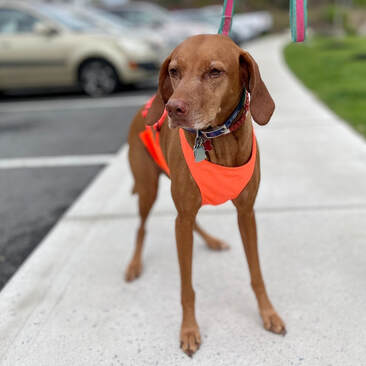 Taking Vanushka for a walk is good for Vanushka and her mom! Taking Vanushka for a walk is good for Vanushka and her mom! Taking your dog out for a walk can also be a great chance for socialization, for you and your pup alike! While we all know socialization is important for our dogs, it’s just as important for us humans. Face-to-face socialization with others has been shown to help alleviate symptoms of depression, especially in individuals over 50 (mental health matters at every age!). So while you might think your trips to the dog park are just for your pup’s benefit, think again! Even short conversations with other dog owners can provide a boost to your mental state. Of course, a lot more goes into owning a pet than cuddles and occasional walks in the park. They need to be fed, groomed, exercised and played with regularly, and require lots of attention and affection. While these responsibilities can seem daunting, especially if you’re already struggling to keep up with the other responsibilities in your life, the two can actually go hand in hand. NAMI, the National Alliance on Mental Illness, find that taking care of another creature can improve pet owners’ sense of self-worth and their confidence in their ability to take care of themselves. Pet ownership also tends to come with routines, and building a routine to take care of your pet can help you stick to your own self-care routines as well. Not to mention, maintaining a regular routine is shown to help improve sleep! Who doesn’t love that? Even now, we’re only beginning to understand the links between animals and mental health. New studies are coming out every day exploring these connections further, and the more we discover the more we can find ways to take advantage of these effects. Animal Assisted Therapy is becoming increasingly popular as a supplement to standard therapy regimens, while new studies are focusing on the impact animals might have on the development of children, especially those with certain conditions such as ADHD or autism. So our pets are pretty cool, huh? But while they love us unconditionally and brighten our days just by being there, we know they can’t do everything. If you’re struggling with mental health and need help or guidance, don’t be afraid to reach out! Mental Health America has put together a wonderful guide that can help you figure out where to start, and can make the process of finding help a little less daunting. And if you won’t do it for our sake, then consider doing it for your pets’. We know it’s what they want. 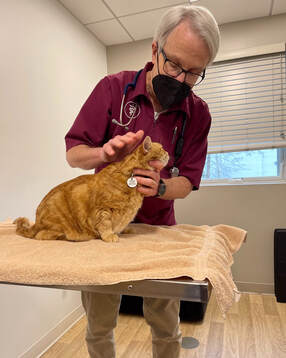 One of our favorite veterinarians, Dr. Hardie, hard at work One of our favorite veterinarians, Dr. Hardie, hard at work On a personal note… As veterinary professionals, Mental Health Awareness Month is a cause close to our hearts. 1 in 6 veterinarians will consider suicide at some point in their career, and the number of veterinarians experiencing extreme psychological distress has increased since the beginning of the pandemic. Not One More Vet is a nonprofit organization that aims to address the growing mental health crisis in the veterinary industry through education, outreach, peer support, and grant programs. Visit their website to learn more, make a charitable donation, or get involved as a volunteer.  Concord Animal Hospital (CAH) is happy to announce the addition of Dr. Katherine Aubert to our team of skilled and compassionate veterinarians! Dr. Aubert joins Drs. Wilson, Carpenter, Fritz, Hardie, Rondeau, and the rest of the CAH team to care for your beloved, furry family members. Dr. Aubert joined our team in March and is an amazing addition! She is a graduate of Acton Boxboro High School and the College of Veterinary Medicine at the University of Minnesota. She practiced locally for seven years before joining the team at CAH. She loves many aspects of veterinary medicine, especially dentistry, geriatric medicine, and treating working dogs. In her spare time, Dr. Aubert enjoys crafting, gardening, and seeing live music. She also volunteers with The Street Dog Coalition, helping to provide medical care to pets of people experiencing, or at risk of, homelessness. She shares her home with Davy and Olive, two Cavalier King Charles Spaniels. Click to request an appointment with Dr. Aubert or another CAH veterinarian. 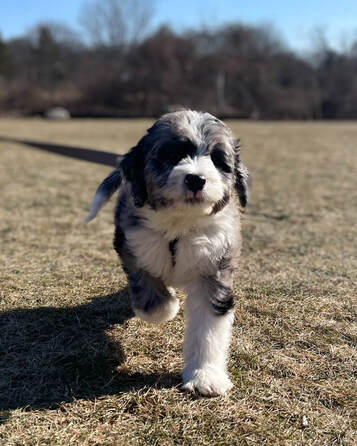 Spring has sprung and warm weather is close behind! But while we’re still a ways out from those beach trips with your canine friends, there is one summer surprise that can make an unseasonal appearance- and unfortunately it’s not a fun one. Today we’re talking heat stroke: what is it, what can you do to prevent it, and how should you handle it if it happens? What is heat stroke? How do you cool off on a hot summer day? Maybe you crank the air conditioning or enjoy a delicious frozen snack, and your body probably sweats off as much heat as it can. But dogs barely have any sweat glands, and their paws aren’t very good at working the knob on the AC. So they’re at a much higher risk of heat stroke than we are! If the air temperature gets higher than your pet’s body temperature, or high enough that they can’t discharge heat effectively, then their body temperature can start to spike. This can have a number of nasty effects, including damage to the gastrointestinal tract, eyes, and brain. If left untreated, heat stroke can quickly prove fatal. When can heat stroke occur? We know what you’re thinking: “Posting about heat stroke during a New England April? That’s a little premature, isn’t it?” But heat stroke can happen more easily than you think! One of the leading causes of year-round heat stroke is leaving a dog in a car; the American Veterinary Medical Association reports that the temperature inside a car can get more than forty degrees higher than the outside temperature over the course of an hour. That means a breezy 60 degrees can become a sweltering 100 for your poor stranded pup! There are certain risk factors that can make your dog more susceptible to heat stroke as well. Brachycephalic dogs (the fancy medical term for short-nosed dogs like pugs and bulldogs) and dogs with heavy coats are at an increased risk, along with dogs who are elderly or obese, and dogs with certain pre-existing conditions such as hyperthyroidism or heart disease. Cats can also suffer from heat stroke, but are at a lower risk thanks to their penchant for lazily lounging around the house. But you should still make sure your cat has a cool, cozy space to relax during those hot summer months! Spotting the Signs How can you tell if your dog might be suffering from heat stroke? The most reliable way is to put them through veterinary school so they can diagnose themselves if needed, but if that’s not a viable option there are a few key signs you can watch out for instead. The most telltale sign of potential heat stroke is excessive panting. Since dogs don’t sweat, panting is their main way of regulating their body temperature. More panting means more heat to get rid of, and more risk of not being able to keep up. Other notable symptoms include pale or flushed gums, lethargy, disorientation, bloodshot eyes, or seizing. 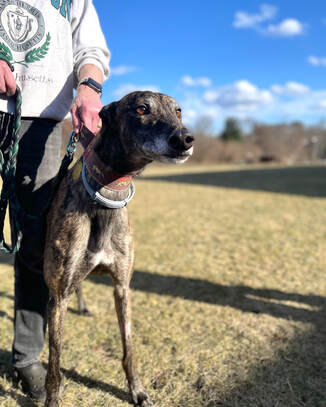 Beat the Heat (Stroke) If you believe your pet is suffering from heat stroke you should have them seen with us or an emergency hospital as quickly as possible, but there are a few additional steps you can take to vastly improve your pup’s prognosis. Dousing them with cold water from a hose, bath, or sink can help to lower their body temperature, as can ice packs placed around the armpits and belly. Avoid covering your dog with wet towels, as this will actually trap heat against their body and prevent them from cooling. Once your dog’s in the car crank the air conditioning or roll down the windows, and if you’re on your way to an emergency hospital call ahead to let them know when you’ll be there. An Ounce of Prevention… Is worth avoiding some very expensive ER bills! Heat stroke is a fully preventable condition, and with just a few adjustments to your warm weather activities you can help protect your pet from this thermodynamic threat. Always make sure your pet has access to fresh water and keep a water bottle on you if you’re going outside. Avoid going out for walks during the hottest parts of the day, and never ever leave your pet alone in your car! And as always, if you have any questions or are concerned something might be wrong with your pet, give us a call! Our staff are always happy to help you and your pets keep your cool. 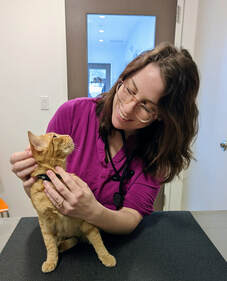 Dr. McCullough will be the Veterinarian at the sister hospital Dr. McCullough will be the Veterinarian at the sister hospital The team at Concord Animal Hospital is excited to open a second veterinary clinic. Located in Burlington, MA, Cambridge Street Animal Hospital is scheduled to open in May 2022. A happy effect of the COVID-19 pandemic has been a dramatic increase in pet ownership. While the proliferation of new pets is amazing, it’s straining the capacity of animal care services. “Our team sees a need for increased pet healthcare services across our region,” says Concord Animal Hospital co-owner and Hospital Administrator Katherine Wilson. “We hope to help meet the needs of a broader community with our sister hospital in Burlington.” 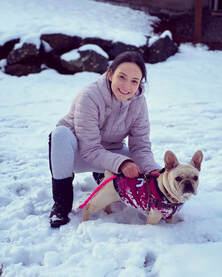 Stephanie Saglimbeni will be the Hospital Manager Stephanie Saglimbeni will be the Hospital Manager Three members of the Concord Animal Hospital team will move to the new hospital once it opens. Dr. Rhea McCullough will be the practicing Veterinarian, Stephanie Saglimbeni will be the Hospital Administrator and Charlene McLaughlin will be Head Groomer. Concord Animal Hospital has hired new team members to take their places in time for their transition in the spring. “We’re excited about the opportunity to practice the same high-quality and compassionate care we deliver in Concord to the pets of Burlington,” says Dr. McCullough. You can follow the new hospital’s progress by visiting their website and following them on social media: cambridgestreetanimalhospital.com. Clients who would prefer to have their pets cared for or groomed by the team at Cambridge Street Animal Hospital can either let our front desk know or sign up on the Cambridge Street Animal Hospital website! In our continued efforts to provide the highest standard in medical care for your pets, we are thrilled to announce the addition of laparoscopic surgery to Concord Animal Hospital's services.
 Petal three days after her LOVE Spay Petal three days after her LOVE Spay Laparoscopy has been used in human medicine for the past 25 years and the team at Concord Animal Hospital is excited to help drive its adoption in veterinary medicine. “A laparoscopic procedure offers so many benefits for pets and owners,” says CAH owner and Veterinarian Dr. Wilson. “The incisions are significantly smaller, there is less tissue handling, and less time under anesthesia. All of this results in a faster and safer procedure for pets. The recovery time is days instead of weeks and your pet will be in far less pain.” Dr. Wilson adds, “yes, that does mean just a couple of days in a cone with exercise restriction instead of two weeks. This is a tremendous benefit, especially for puppy owners!” Laparoscopy is not necessary for all surgical procedures. “Laparoscopy is a great alternative for procedures where the team needs to access deeper into the body cavity. These procedures require large incisions and handling of vessels and tissue with a traditional surgery,” notes Dr. Wilson. “A LOVE Spay, short for a laparoscopic ovariectomy, is a great spay alternative for large breed dogs, overweight pets, and for pets who have gone through a heat cycle.” With some exceptions, your veterinarian will recommend a traditional surgery for neuters of male pets instead of a laparoscopic surgery. |
|||||||||||||||||||||||||||
|
OFFICE HOURS:
Monday-Friday: 8:00 am to 6:00 pm Saturday: 8:00 am to 12:00 pm |
CONTACT INFORMATION:
Concord Animal Hospital 245 Baker Avenue Concord, MA 01742 Phone: (978) 369-3503 Fax: (978) 371-9748 [email protected] |
JOIN OUR PACK!
Sign up for our monthly newsletter, the Paw Press for hospital news, pet care tips and cute pet photos! |
Copyright © 2022

